Taxila in Focus
100 years since Marshall
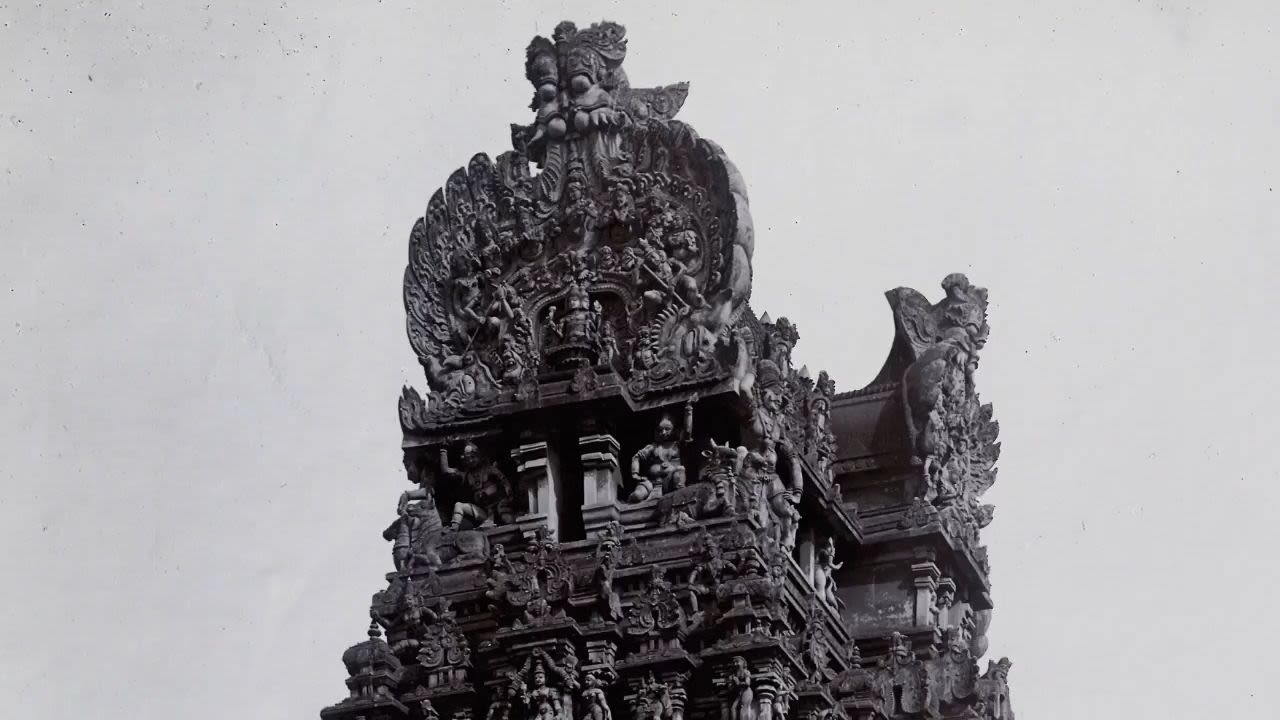
Durham University’s Oriental Museum is home to nearly 5000 images from the personal archives of Sir John Hubert Marshall CIE, FBA (1876-1958).
While Director-General of the Archaeological Survey of India between 1902 and 1931, Marshall collected photographs and technical drawings of many significant sites and monuments across the modern nation states of Bangladesh, India, Myanmar and Pakistan.
His collection included images of archaeological excavations, as well as artefacts, architectural monuments and sculpture from sites dating from prehistoric times through to the Colonial period.
Click the icons on the map to view images from the sites excavated by Sir John Marshall.
This exhibition focuses on the ancient city of Taxila, now a UNESCO World Heritage Site in Pakistan, and only 32 kilometres from its federal capital, Islamabad. Taxila, translated by many as ‘City of Cut Stone’, was a cosmopolitan settlement and a major trading hub. It flourished for centuries, benefitting from the flow of goods, ideas and faiths that travelled eastwards and westwards along the famed Silk Roads.
Marshall began a sustained 21-year campaign of excavations at Taxila in 1913. His excavations were recorded on film, and Taxila in Focus explores what these visual documents can tell us about the site and the practice of archaeology in early 20th century South Asia.
With reference to a new corpus of photography, this exhibition also explores the ways in which Durham’s significant archive of early imagery can today contribute to the protection and management of key sites and monuments in Pakistan and South Asia in the present.
“This…picture…arises from explorations and excavations, but goes beyond them to present, for the first time, a global view of the historic city as it developed in the mingling of men and women from east and west. Taxila exemplifies a panorama of humanity that has been full of life, activity, idealism and the struggle for ultimate goals. The silent remains speak for themselves and bring into view what was once the glory of Taxila.”
Ahmad Hasan Dani (1999: xi)
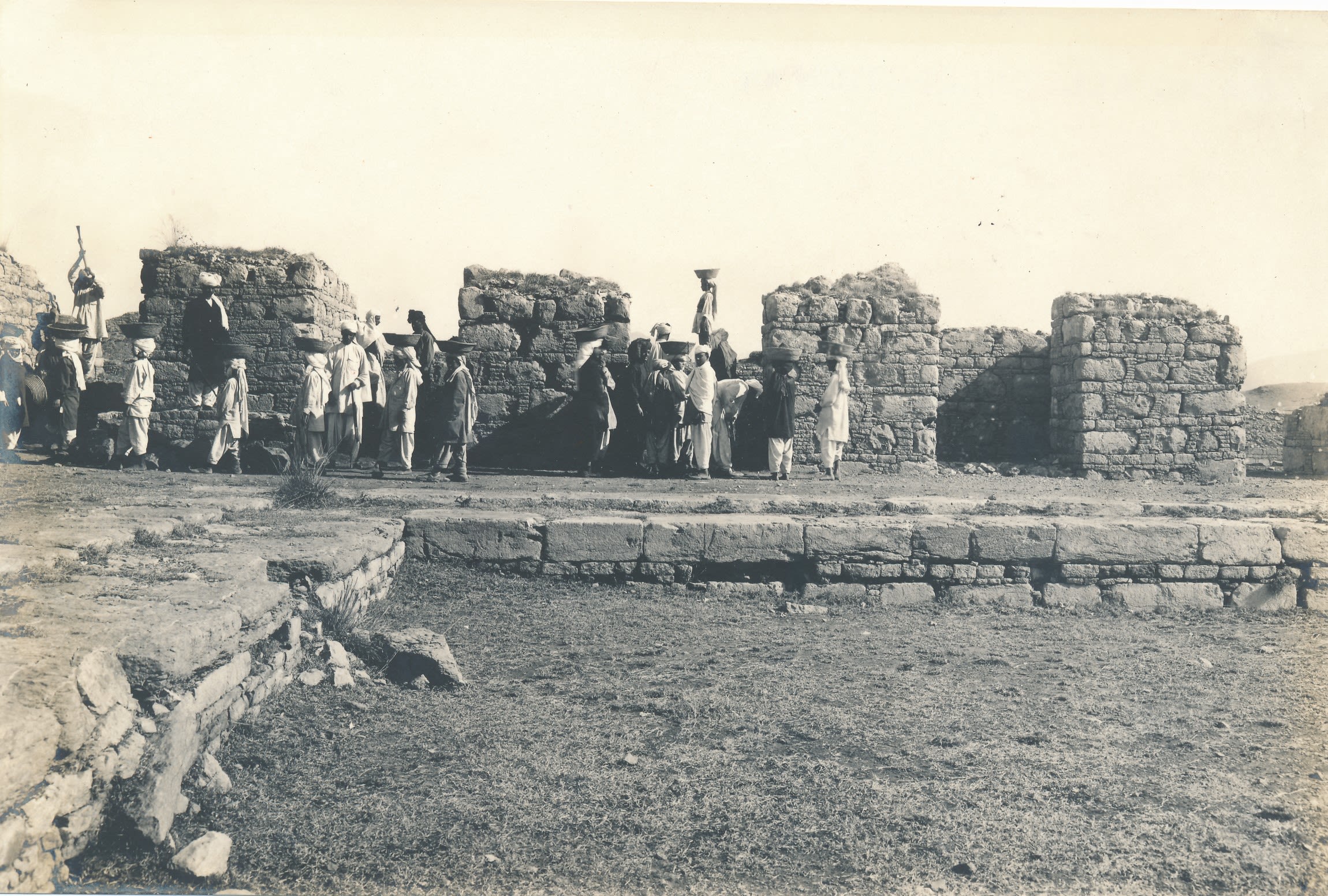
Sir John Marshall at Taxila
“I could not have wished for a steadier or more pleasant crowd of diggers than those who toiled with me at Taxila; and let us not forget that it is to the toil and sweat of the diggers that, first and foremost, we owe the vast majority of our archaeological treasures”
Marshall, Taxila (1951: xv)
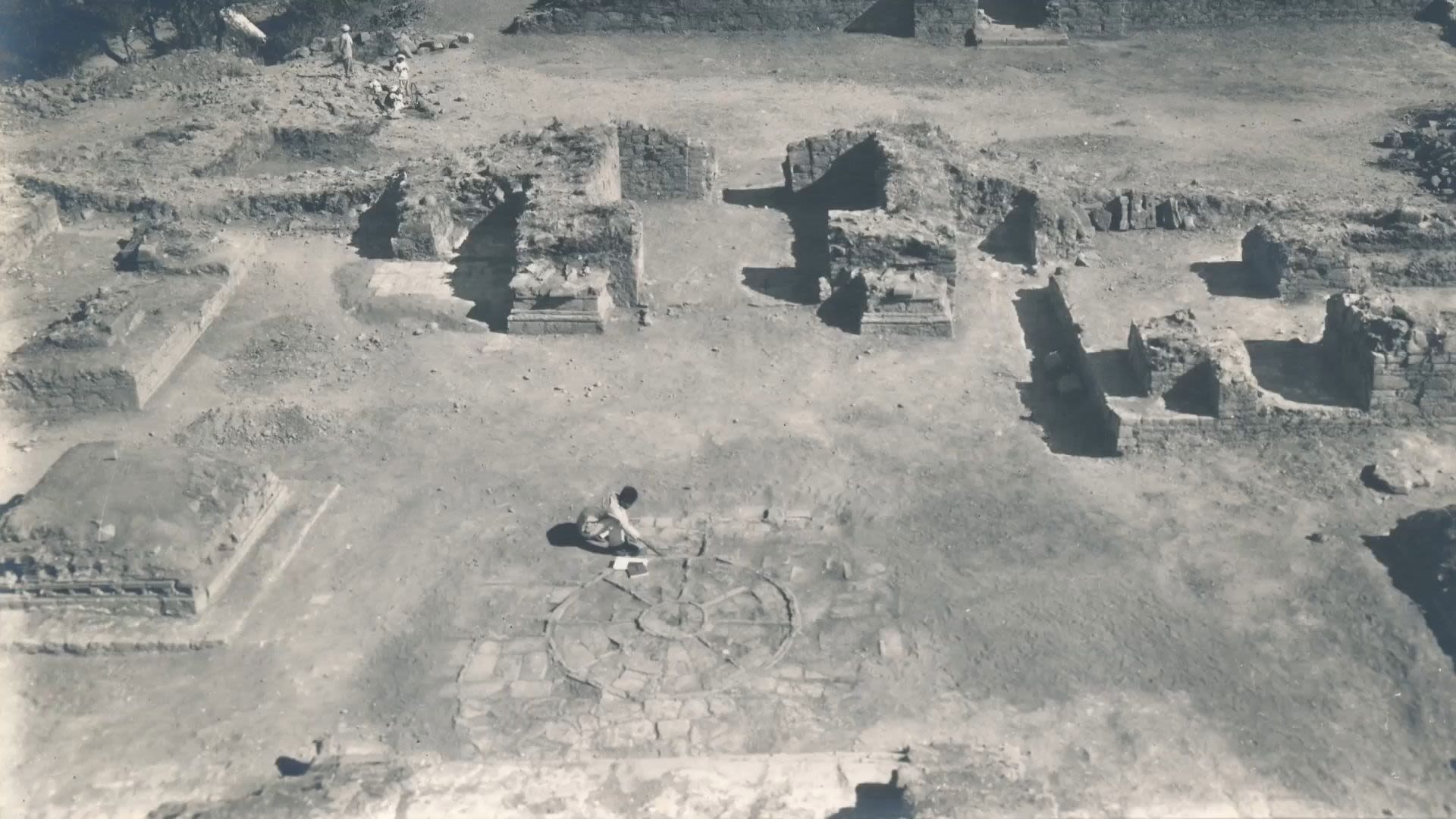
Mentioned in the ancient South Asian epic, the Ramayana, and early Buddhist and Jain traditions, Taxila was one of the ancient capitals of Gandhara, an important territory stretching between the Oxus and Indus Rivers.
Although the Taxila Valley was first surveyed in the 19th century, much of what we know about the site was revealed by intensive excavations directed by Sir John Marshall. A western Classical scholar by training, he was drawn to Taxila by its rich historical associations with Darius I, Alexander the Great and the Emperor Asoka as well as by the site’s Buddhist sculptures, in which he recognised western Classical influences.
A significant meeting point of trade and exchange on the ancient Silk Roads, Taxila emerged as a major commercial hub and political centre for successive historic states and empires. Its uniqueness, preservation and international significance led to Taxila’s inscription on UNESCO’s list of World Heritage Sites in 1980.
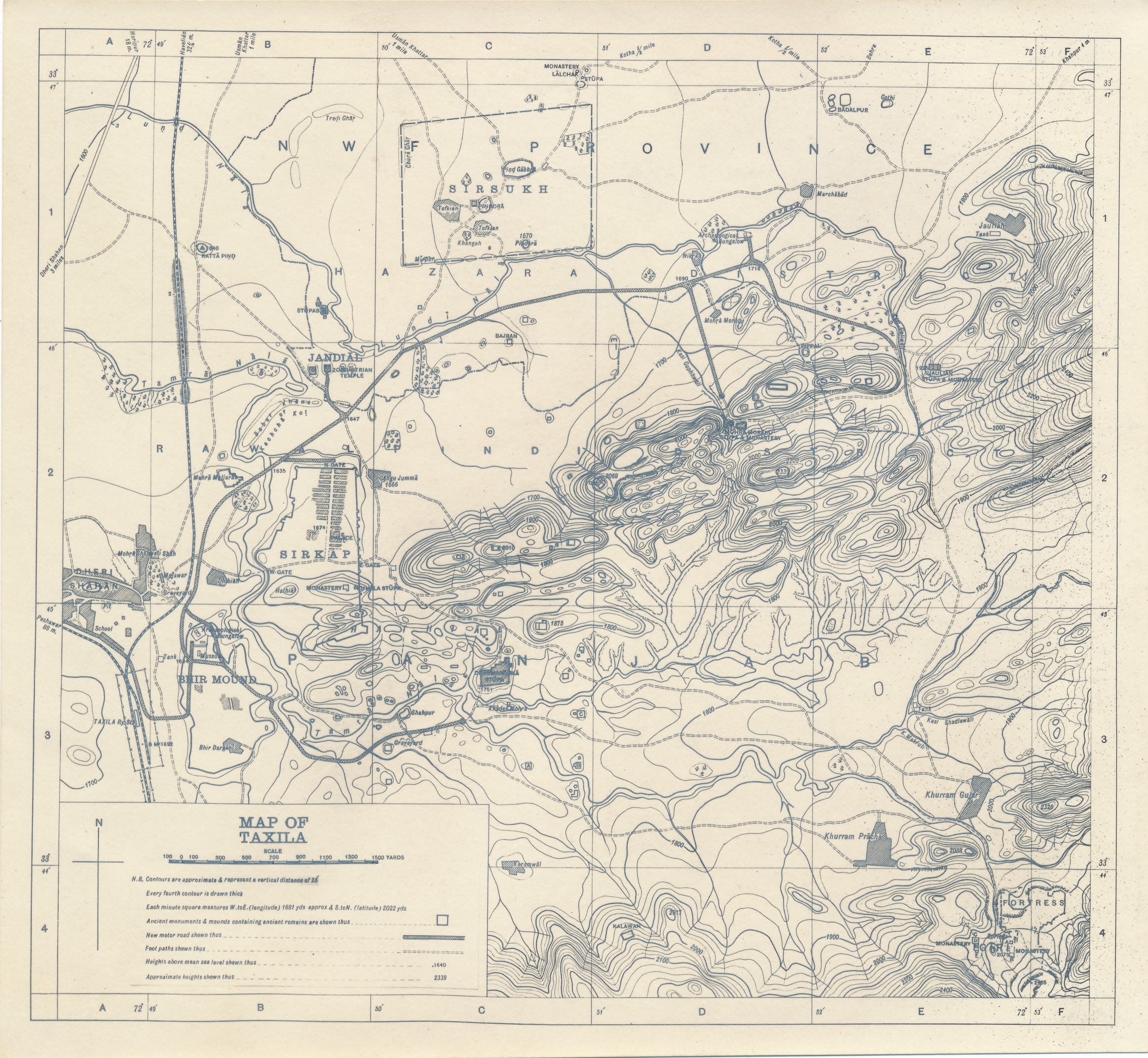
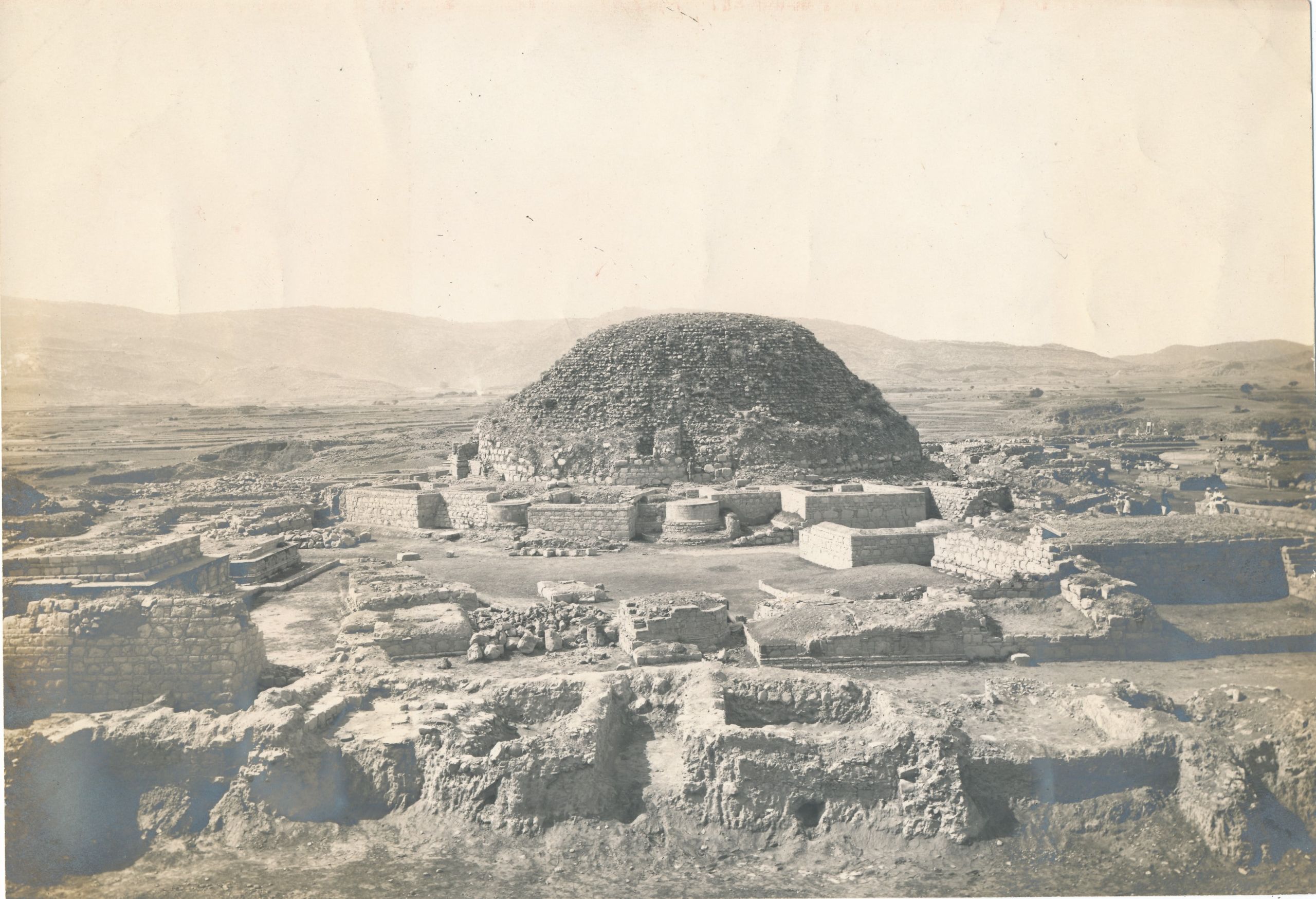
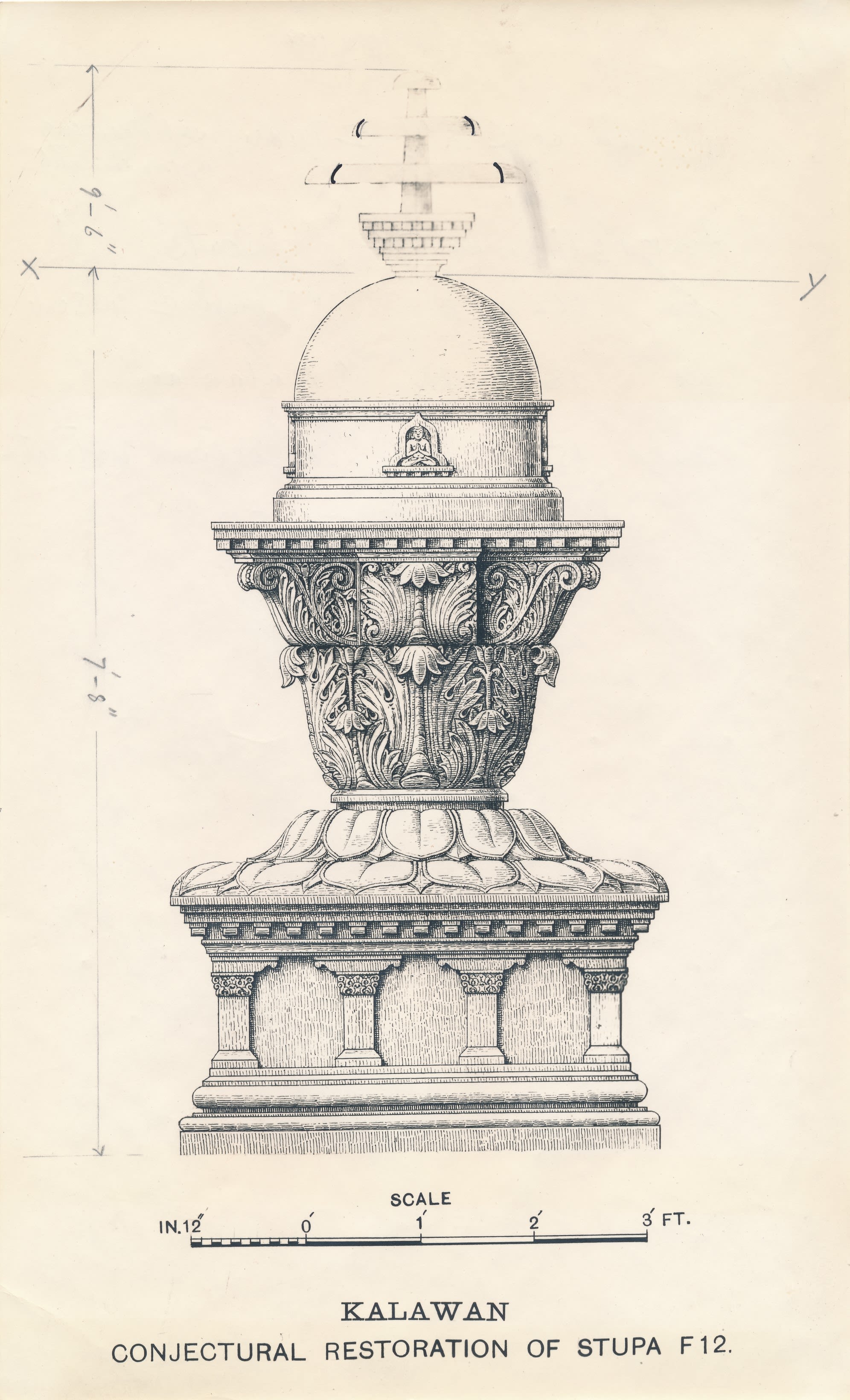
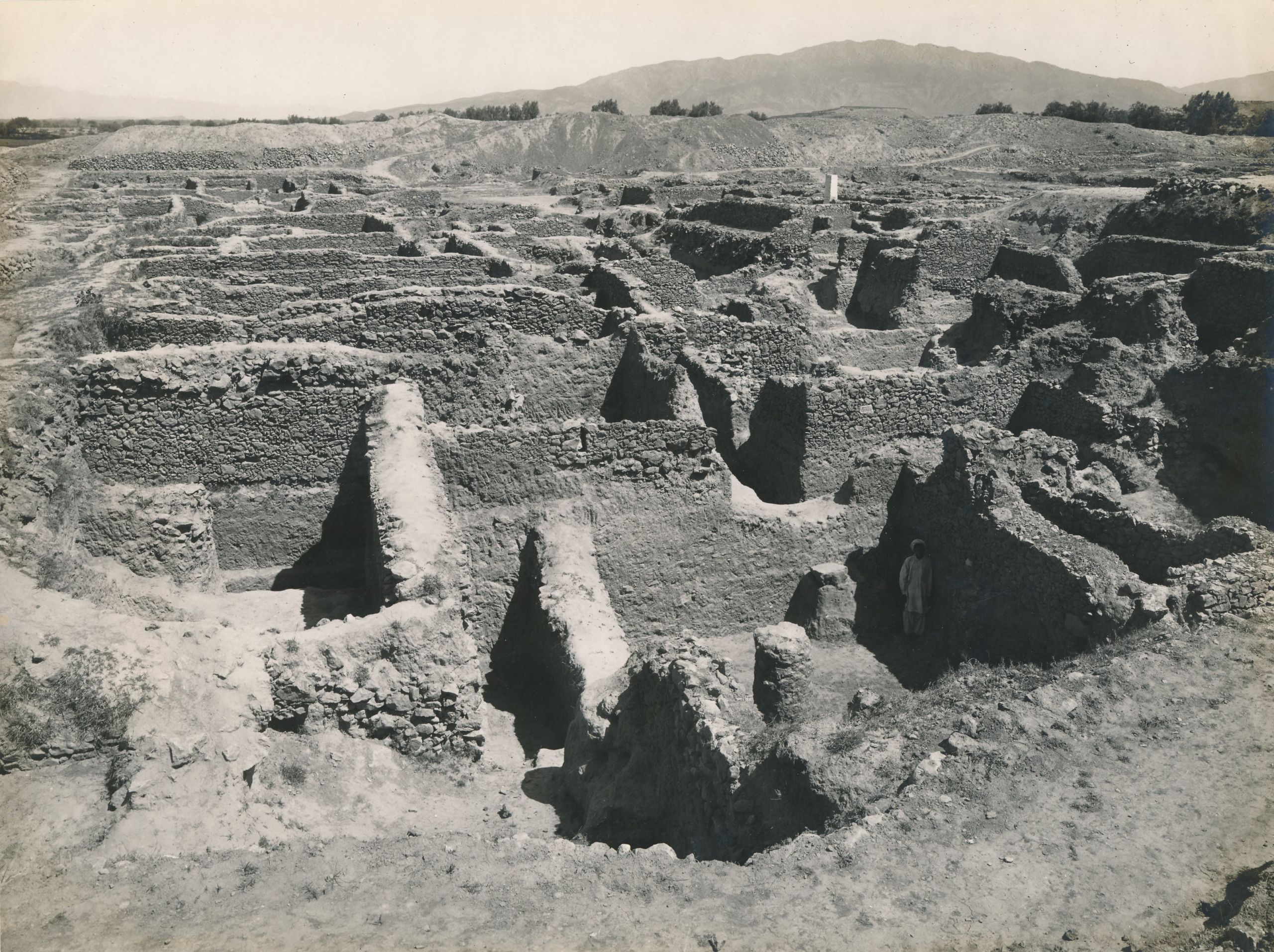
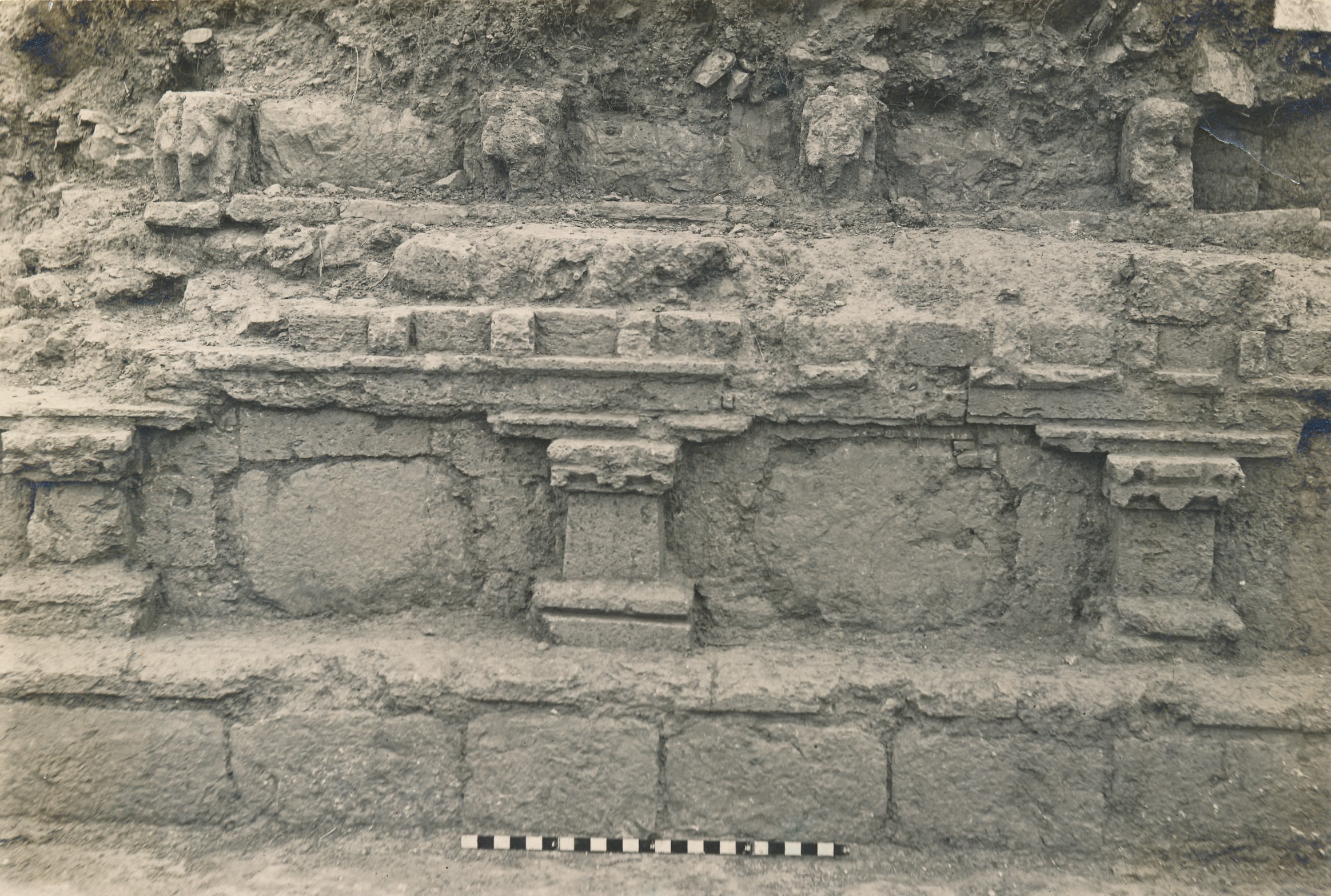
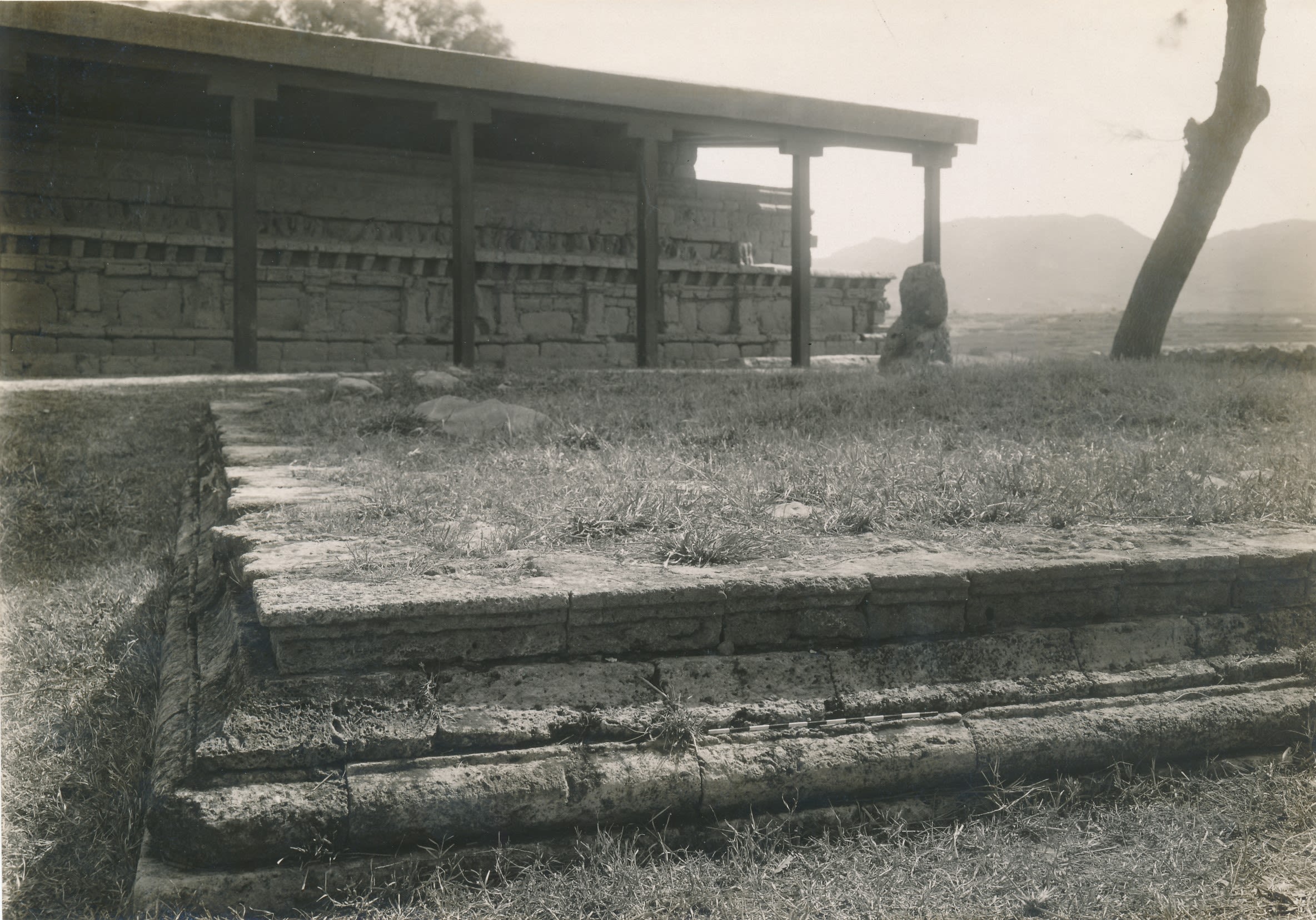

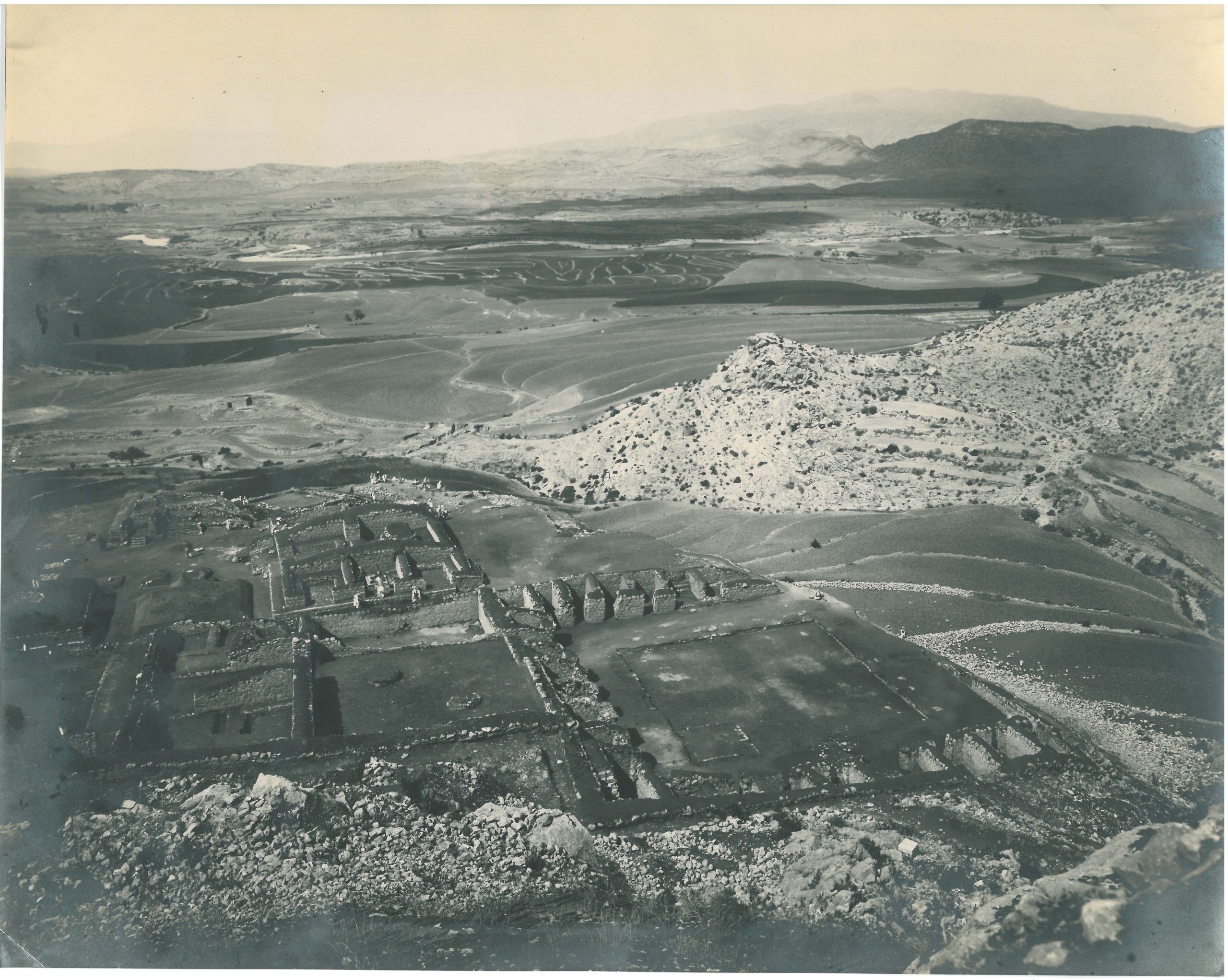
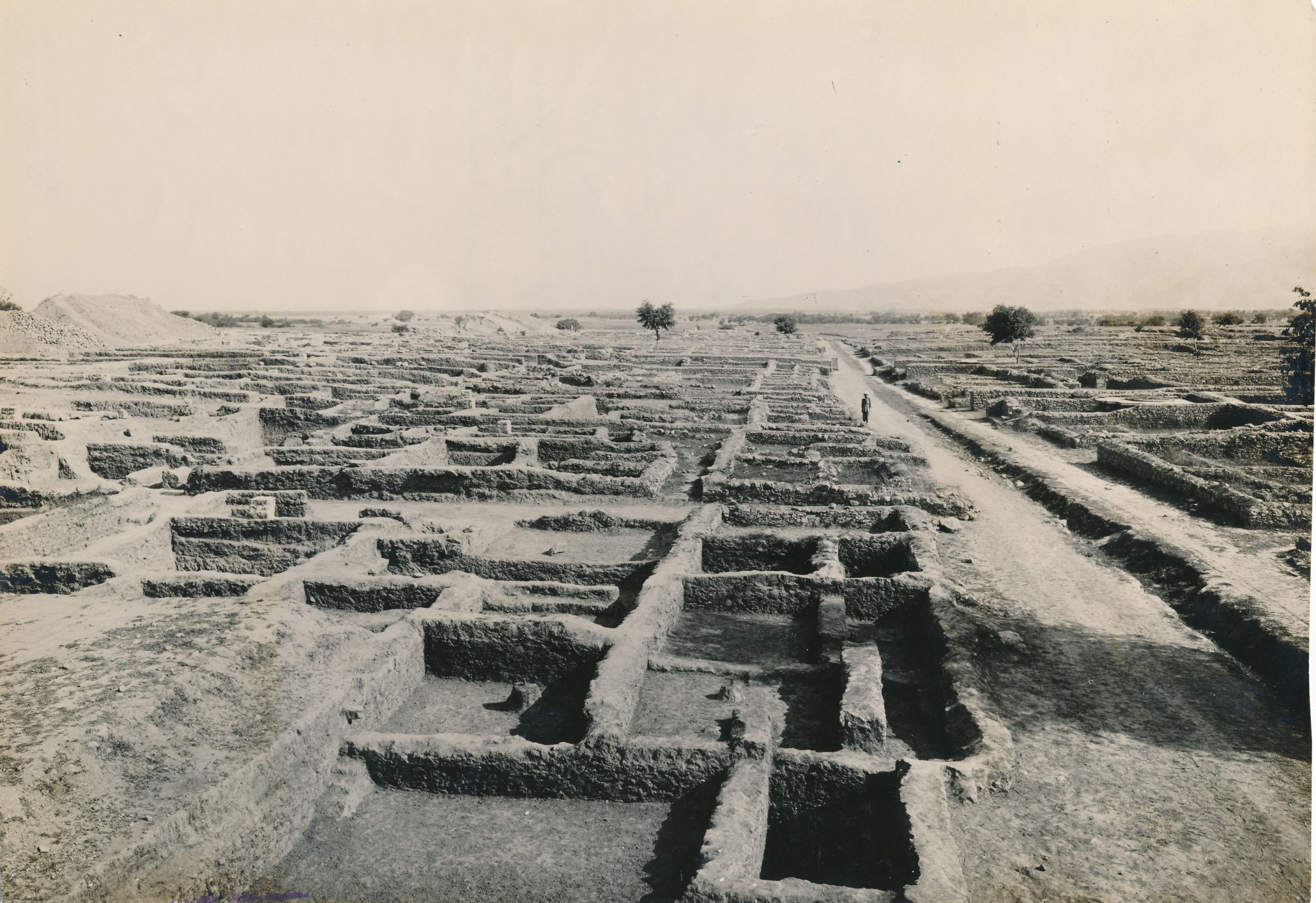
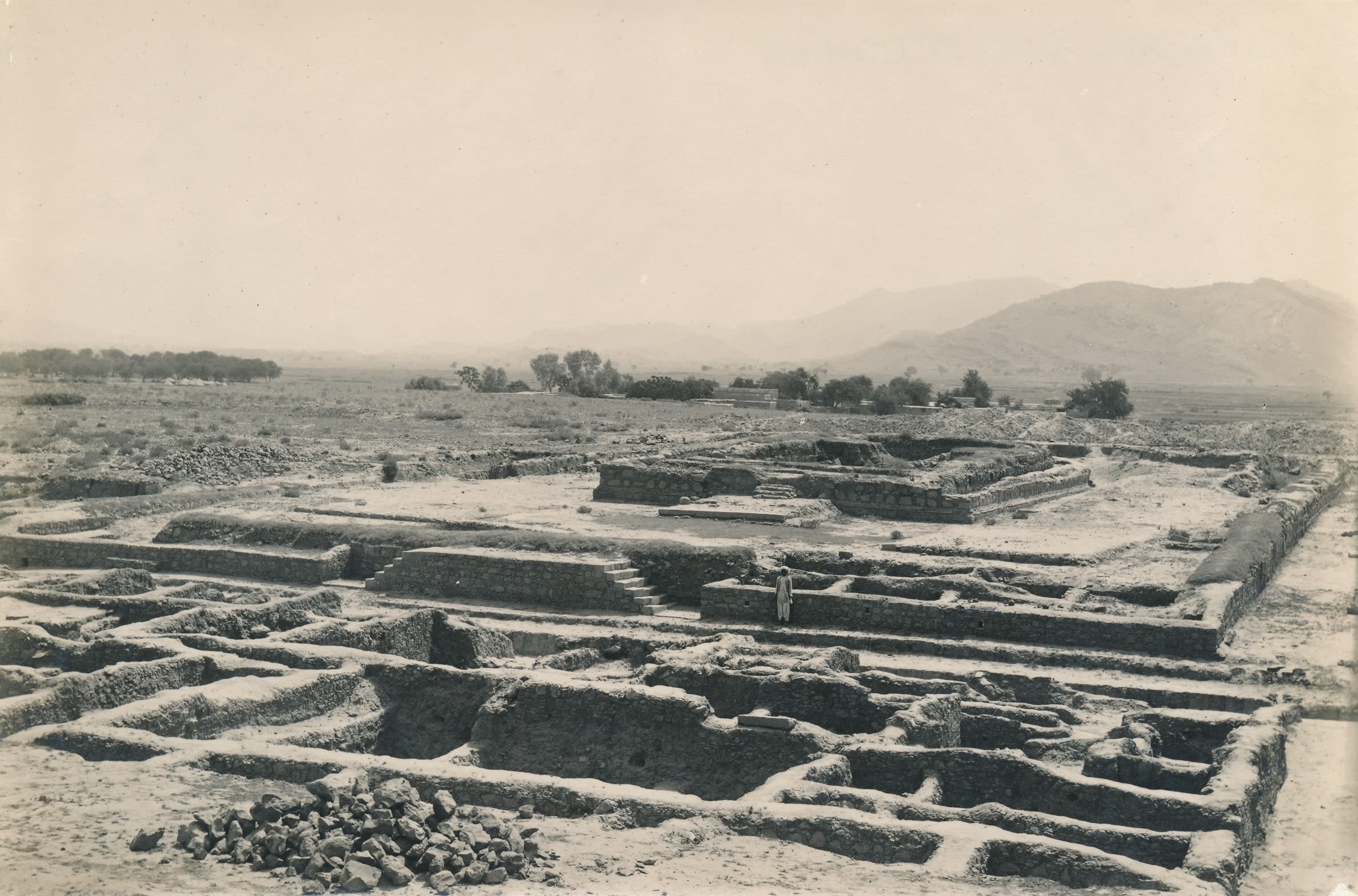
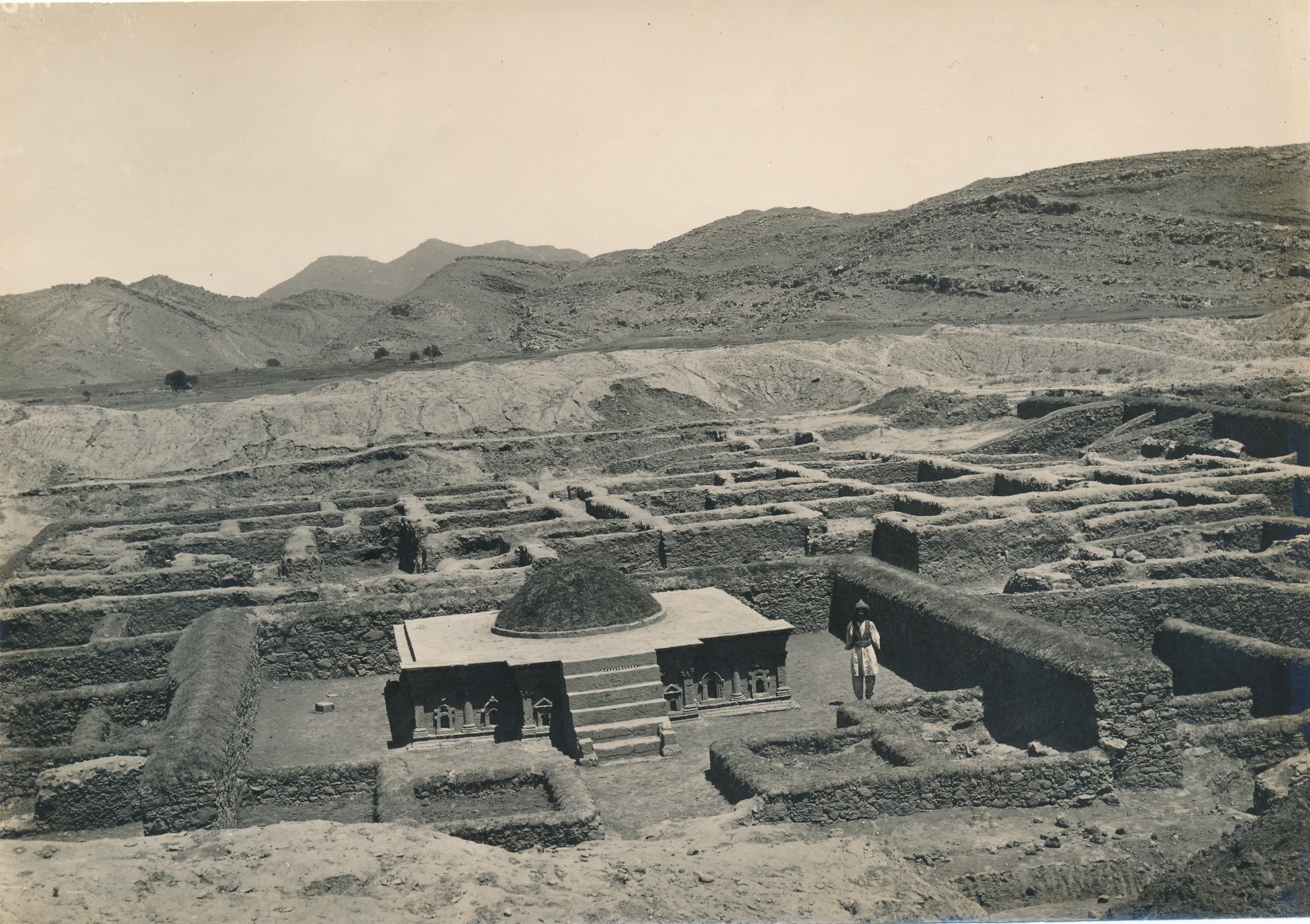
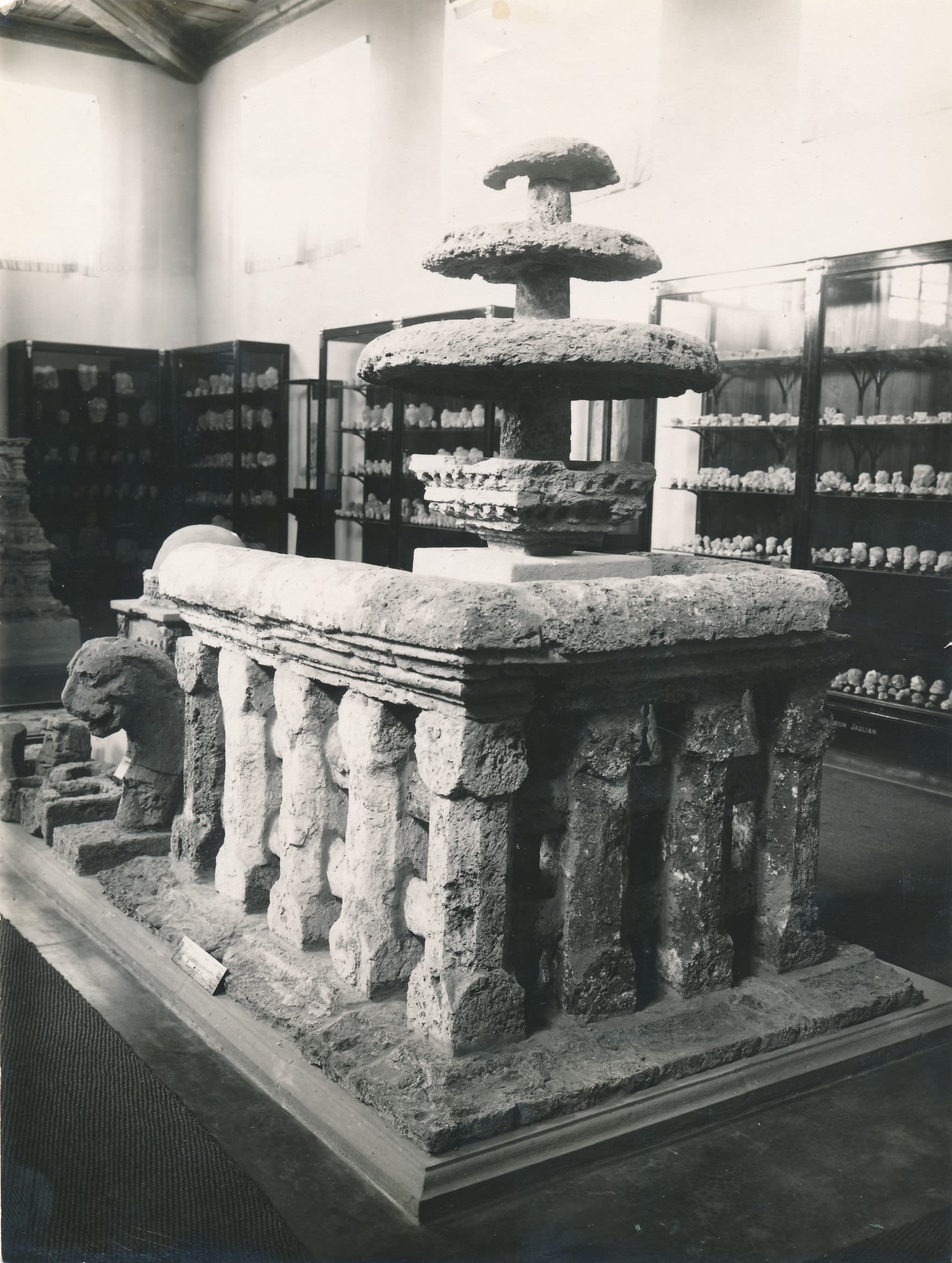
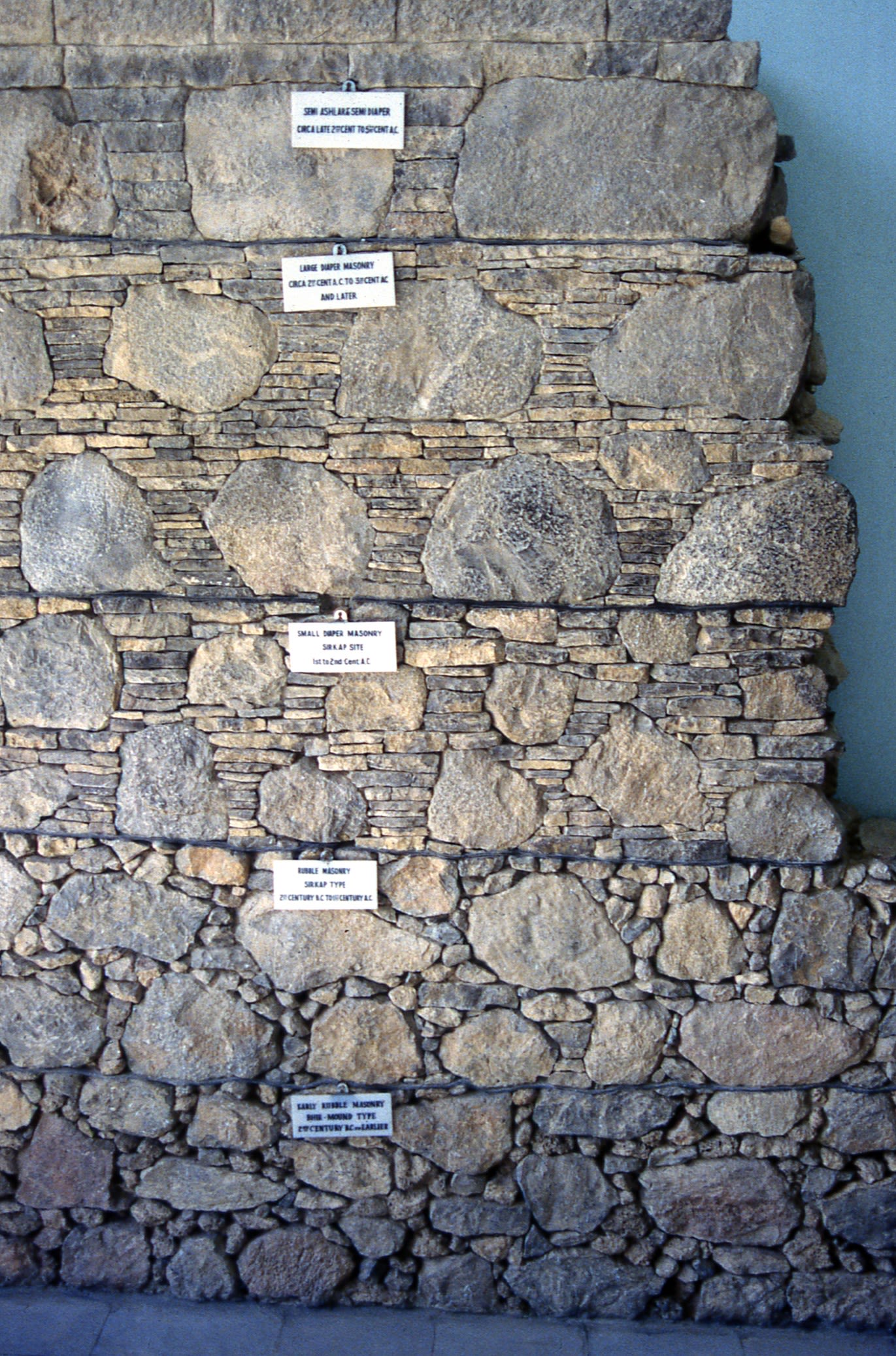
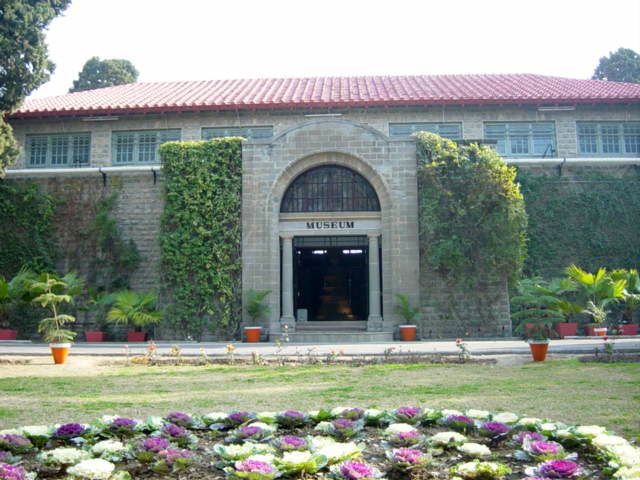

Early 20th century map of the Taxila Valley published by Sir John Marshall. Sir John Marshall Collection, given by Dr and Mrs Spalding. DUROM.1957.1.1290
Early 20th century map of the Taxila Valley published by Sir John Marshall. Sir John Marshall Collection, given by Dr and Mrs Spalding. DUROM.1957.1.1290

General view of the Great Stupa at Dharmarajika, Taxila, taken in 1916/1917. (c.3rd century BCE-5th century CE) Sir John Marshall Collection, given by Dr and Mrs Spalding. DUROM.1957.1.1379
General view of the Great Stupa at Dharmarajika, Taxila, taken in 1916/1917. (c.3rd century BCE-5th century CE) Sir John Marshall Collection, given by Dr and Mrs Spalding. DUROM.1957.1.1379

Conjectural reconstruction of Stupa F12 in the Kalawan Monastery, Taxila. (c.1st-5th century CE) Sir John Marshall Collection, given by Dr and Mrs Spalding. DUROM.1957.1.1629
Conjectural reconstruction of Stupa F12 in the Kalawan Monastery, Taxila. (c.1st-5th century CE) Sir John Marshall Collection, given by Dr and Mrs Spalding. DUROM.1957.1.1629

View of buildings exposed during excavations within the Bhir Mound, Taxila, taken in 1930/1931. (c.5th century BCE-1st century CE) Sir John Marshall Collection, given by Dr and Mrs Spalding. DUROM.1957.1.1335
View of buildings exposed during excavations within the Bhir Mound, Taxila, taken in 1930/1931. (c.5th century BCE-1st century CE) Sir John Marshall Collection, given by Dr and Mrs Spalding. DUROM.1957.1.1335

Detail of stucco moulding exposed during the excavations of the plinth of Stupa J1 at Dharmarajika, Taxila, taken in 1912/1913. (c.2nd-5th century CE) Sir John Marshall Collection, given by Dr and Mrs Spalding. DUROM.1957.1.1417
Detail of stucco moulding exposed during the excavations of the plinth of Stupa J1 at Dharmarajika, Taxila, taken in 1912/1913. (c.2nd-5th century CE) Sir John Marshall Collection, given by Dr and Mrs Spalding. DUROM.1957.1.1417

Detail of surviving plinth of Stupa D4 with the remains of Stupa J1 under a conservation shelter behind at Dharmarajika, Taxila, taken in 1917/1918. (c.2nd-5th Century CE) Sir John Marshall Collection, given by Dr and Mrs Spalding. DUROM.1957.1.1418
Detail of surviving plinth of Stupa D4 with the remains of Stupa J1 under a conservation shelter behind at Dharmarajika, Taxila, taken in 1917/1918. (c.2nd-5th Century CE) Sir John Marshall Collection, given by Dr and Mrs Spalding. DUROM.1957.1.1418

View of Monastic Quadrangle F at Jaulian, Taxila, taken in 1916/1917. (c.2nd-5th century CE) Sir John Marshall Collection, given by Dr and Mrs Spalding. DUROM.1957.1.1599
View of Monastic Quadrangle F at Jaulian, Taxila, taken in 1916/1917. (c.2nd-5th century CE) Sir John Marshall Collection, given by Dr and Mrs Spalding. DUROM.1957.1.1599

Aerial view across the excavations of the stupa court and monastic quadrangles at Kalawan, Taxila, taken in 1932/1933. (c.1st-5th century CE) Sir John Marshall Collection, given by Dr and Mrs Spalding. DUROM.1957.1.1608
Aerial view across the excavations of the stupa court and monastic quadrangles at Kalawan, Taxila, taken in 1932/1933. (c.1st-5th century CE) Sir John Marshall Collection, given by Dr and Mrs Spalding. DUROM.1957.1.1608

Street view of exposed structures on either side of Main Street during excavations in the lower city, Sirkap, Taxila, taken in 1928/1929. (c.2nd century BCE-2nd century CE) Sir John Marshall Collection, given by Dr and Mrs Spalding. DUROM.1957.1.1762
Street view of exposed structures on either side of Main Street during excavations in the lower city, Sirkap, Taxila, taken in 1928/1929. (c.2nd century BCE-2nd century CE) Sir John Marshall Collection, given by Dr and Mrs Spalding. DUROM.1957.1.1762

View of excavations in progress at the Apsidal Temple (Temple D), taken in 1914/1915 in the lower city, Sirkap, Taxila. (c.2nd century BCE-2nd century CE) Sir John Marshall Collection, given by Dr and Mrs Spalding. DUROM.1957.1.1765
View of excavations in progress at the Apsidal Temple (Temple D), taken in 1914/1915 in the lower city, Sirkap, Taxila. (c.2nd century BCE-2nd century CE) Sir John Marshall Collection, given by Dr and Mrs Spalding. DUROM.1957.1.1765

View of Shrine 1, ‘the Shrine of the Double-Headed Eagle’ in Block F of the lower city, Sirkap, Taxila, taken in 1912/1913, after conservation. (c.1st century BCE-1st century CE) Sir John Marshall Collection, given by Dr and Mrs Spalding. DUROM.1957.1.1770
View of Shrine 1, ‘the Shrine of the Double-Headed Eagle’ in Block F of the lower city, Sirkap, Taxila, taken in 1912/1913, after conservation. (c.1st century BCE-1st century CE) Sir John Marshall Collection, given by Dr and Mrs Spalding. DUROM.1957.1.1770

Stone railing and umbrellas from the superstructure of ‘the Shrine of the Double-Headed Eagle’, Sirkap, Taxila, after removal, conservation and presentation in Taxila’s Museum. (c.1st century BCE-1st century CE) Sir John Marshall Collection, given by Dr and Mrs Spalding. DUROM.1957.1.1903
Stone railing and umbrellas from the superstructure of ‘the Shrine of the Double-Headed Eagle’, Sirkap, Taxila, after removal, conservation and presentation in Taxila’s Museum. (c.1st century BCE-1st century CE) Sir John Marshall Collection, given by Dr and Mrs Spalding. DUROM.1957.1.1903

Marshall’s reconstruction of the idealised sequence of masonry styles at Taxila from 2nd century BCE to 5th century CE, Taxila Museum, Taxila, Pakistan, Punjab, 1999. (early 20th century CE) Courtesy of Durham UNESCO Chair
Marshall’s reconstruction of the idealised sequence of masonry styles at Taxila from 2nd century BCE to 5th century CE, Taxila Museum, Taxila, Pakistan, Punjab, 1999. (early 20th century CE) Courtesy of Durham UNESCO Chair

Pakistan, Punjab, Taxila, 2021. Front façade of the site museum at Taxila, which was constructed between 1918 and 1928, and extended in 1998. (1918-1928 CE & 1998 CE) Courtesy of Dr Abdul Azeem
Pakistan, Punjab, Taxila, 2021. Front façade of the site museum at Taxila, which was constructed between 1918 and 1928, and extended in 1998. (1918-1928 CE & 1998 CE) Courtesy of Dr Abdul Azeem
Excavating every year between 1913 and 1934, Marshall’s teams exposed hectares of streets and buildings across three successive cities: the Bhir Mound, Sirkap and Sirsukh, as well as many of the temples and Buddhist monasteries across the Valley.
Struck by evidence of external styles, Marshall constructed a site sequence, which relied heavily on western Classical narratives for Taxila’s genesis and development.
Conserved in situ, visitors were able to walk through and explore the ancient settlements and sites. The excavations also uncovered a vast number of artefacts, objects and sculptures. These finds provided glimpses into the daily lives of the site’s ancient inhabitants, and Marshall established one of South Asia’s first site museums at Taxila to house these archaeological discoveries in 1918.
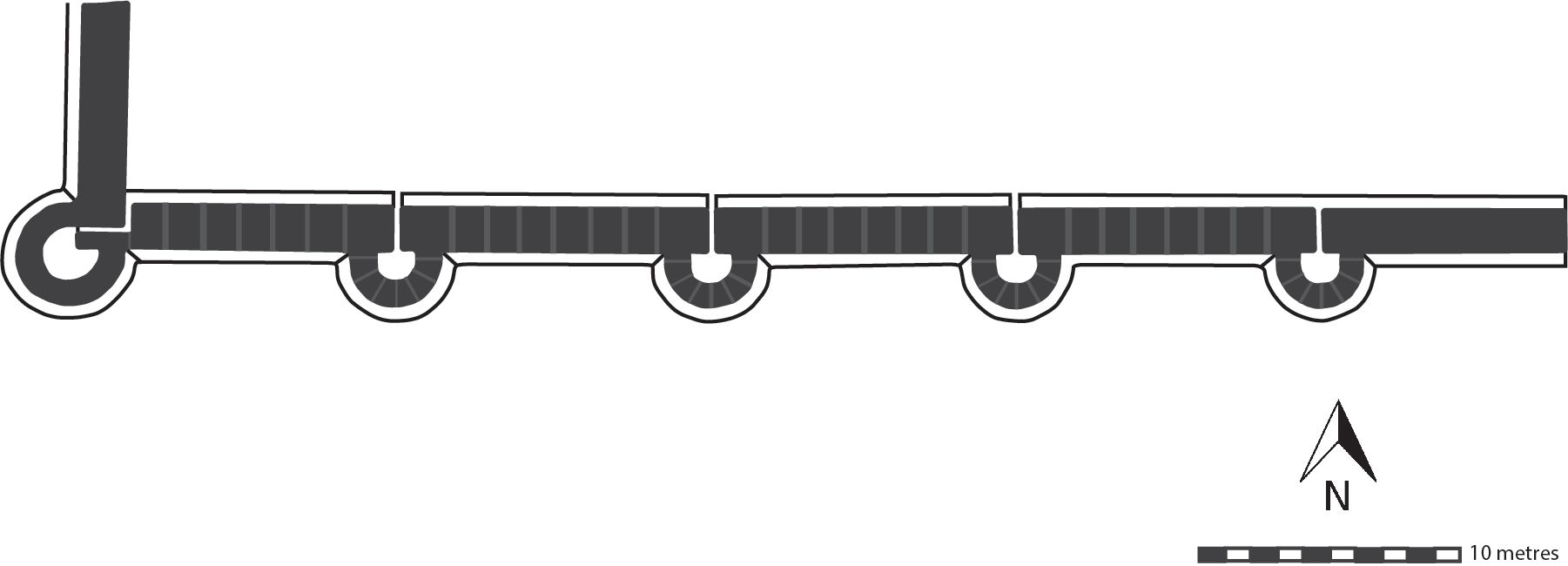
Redrawn illustration of Marshall’s plan of areas excavated at Sirsukh
Redrawn illustration of Marshall’s plan of areas excavated at Sirsukh
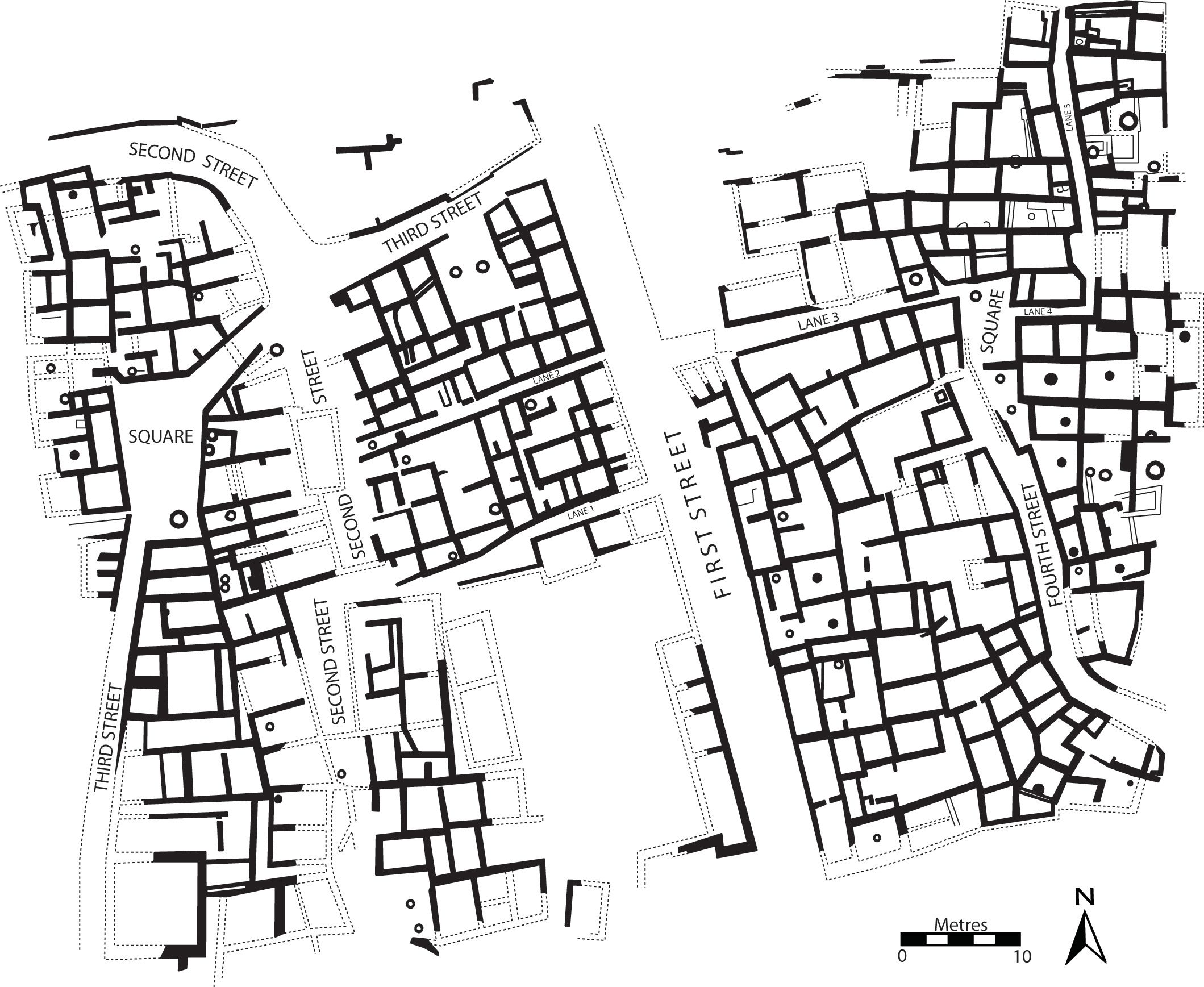
Redrawn illustration of Marshall’s plan of areas excavated at the Bhir Mound. Courtesy of Durham UNESCO Chair
Redrawn illustration of Marshall’s plan of areas excavated at the Bhir Mound. Courtesy of Durham UNESCO Chair
Marshall was also one of the first archaeologists in South Asia to systematically record their discoveries through photography. While a comprehensive official archive of photographs was deposited with the Archaeological Survey of India, and subsequently divided with Pakistan, Marshall also amassed his own personal collection of images to assist his research.
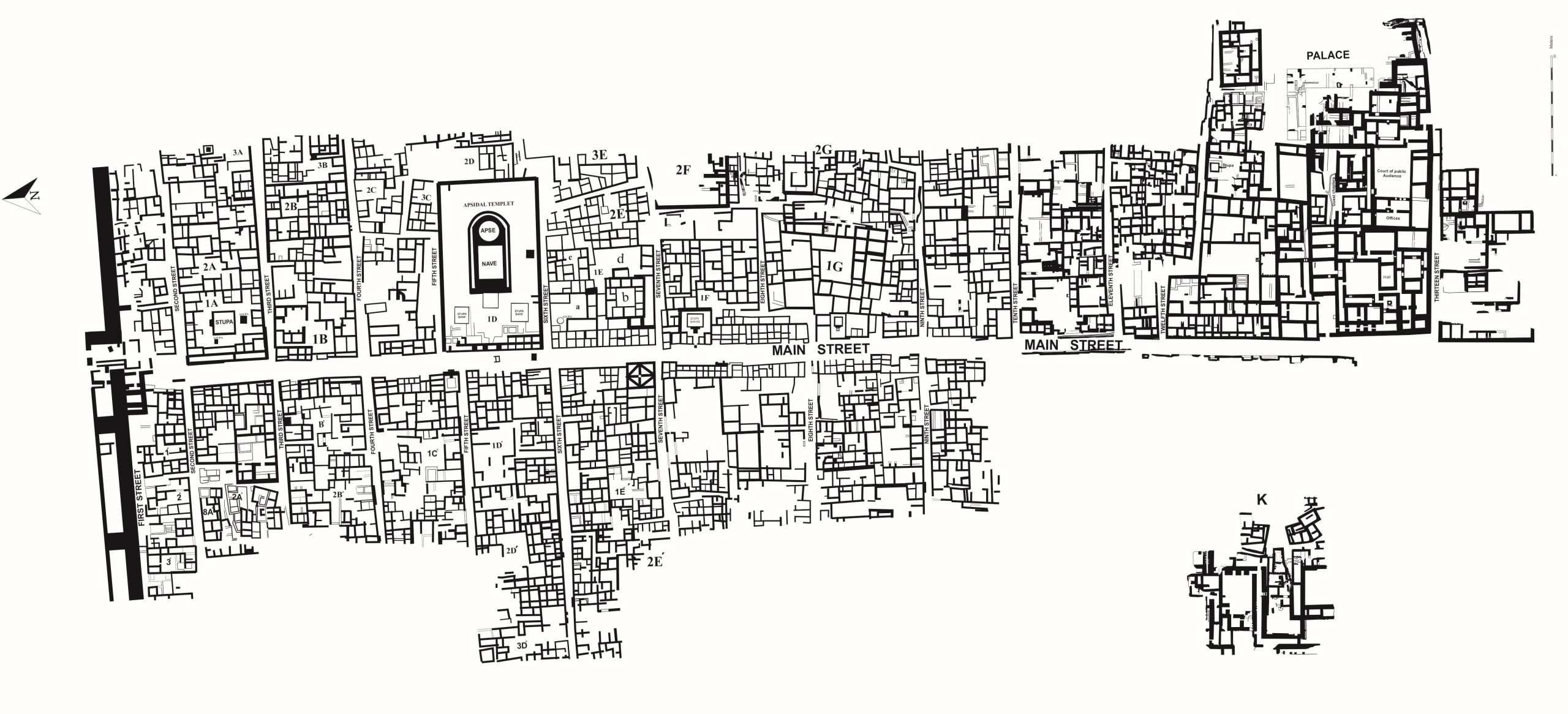
Redrawn illustration of Marshall’s plan of areas excavated at Sirkap. Courtesy of Durham UNESCO Chair
Redrawn illustration of Marshall’s plan of areas excavated at Sirkap. Courtesy of Durham UNESCO Chair
New Light on Marshall

Unlike many Colonial scholars in the service of the British Empire in South Asia, few personal recollections of Marshall’s time as Director-General remain.
He did however understand the importance of promoting wider public and international interest in the archaeology of the region and published the ‘discovery’ of the Chalcolithic Era Indus Valley Civilisation in the London Illustrated News in 1924.
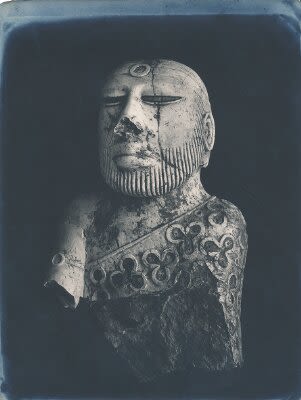
Post-excavation detail of the ‘Priest-King’ of Mohenjo-daro. A rare sculptural fragment, it was interpreted by some archaeologists as the representation of a deity or a priest. (c.2700-1900 BCE) Sir John Marshall Collection, given by Dr and Mrs Spalding. DUROM.1957.1.782

Post-excavation detail of the ‘Priest-King’ of Mohenjo-daro. A rare sculptural fragment, it was interpreted by some archaeologists as the representation of a deity or a priest. (c.2700-1900 BCE) Sir John Marshall Collection, given by Dr and Mrs Spalding. DUROM.1957.1.782
Post-excavation detail of the ‘Priest-King’ of Mohenjo-daro. A rare sculptural fragment, it was interpreted by some archaeologists as the representation of a deity or a priest. (c.2700-1900 BCE) Sir John Marshall Collection, given by Dr and Mrs Spalding. DUROM.1957.1.782
Born in Chester in 1876, Marshall studied at Dulwich College in London and King’s College, Cambridge, from where he graduated in 1900. Following a western Classical path, he then went to work on excavations conducted by the British School in Athens, and was awarded the Craven Studentship in 1901.
Contemporary correspondence reveals insights into his time in Greece and Crete, recording that he was once injured falling off a horse, and that one of his excavations was deemed unauthorised, described by David Hogarth, then Director of the British School at Athens as “a piece of piracy of Marshall’s”. This did not hold Marshall’s career back, and he was appointed Director-General of the newly reformed Archaeological Survey of India in 1902.
The scientific rigour of Marshall’s work in South Asia was challenged by one of his successors, Sir Mortimer Wheeler. Promoting his own systematic approach, Wheeler stated that archaeology in South Asia had been a "parody of scientific method" prior to his arrival. In spite of such criticisms, Marshall has been credited with initiating comprehensive frameworks for monument conservation and heritage protection across South Asia.
“Meanwhile I have not forgotten the photographs for Durham, and have been making a great effort to classify and arrange and title them. The task is bigger than I thought; for I had quite forgotten how many and how diversified they were...”
Extract of a letter from Marshall to H.N. Spalding dated to June 1st 1953
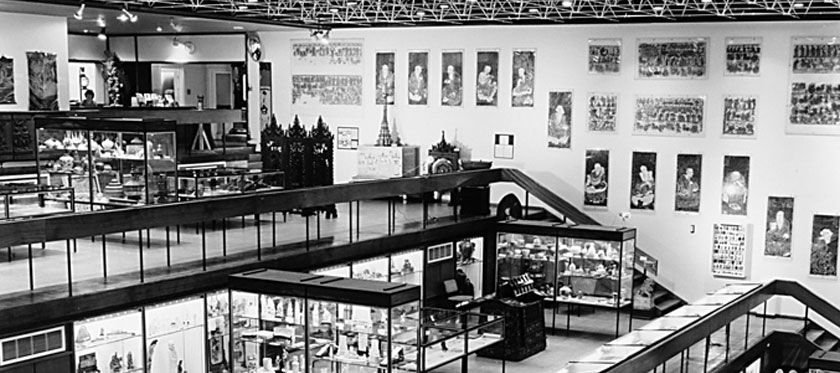
Marshall and Durham University
Although Mortimer Wheeler complained that Marshall’s “clearance did not conform with modern technical standards”, the photographs and excavation records from Taxila provide one of the best documented archaeological investigations in the history of South Asian archaeology.
Marshall may have refrained from discussing his personal experiences as an archaeologist in the popular media, but he remained acutely aware of the importance of his work to wider public appreciation of South Asian art, architecture and archaeology.
Before Marshall’s death in 1958, at the age of 82, Dr and Mrs H.N. Spalding, important benefactors of the fledgling Oriental Museum, encouraged him to donate nearly 5000 images from his personal collection to Durham University. The Museum was delighted to accept the collection and its founder-curator, Professor Thomas Thacker, proclaimed that “The collection of photographs seems a most remarkable one, and one which we shall be lucky to possess”.
The Marshall Collection today represents an important research and teaching resource that attracts scholars from across the globe to Durham University. It has been central to a number of international collaborative projects and images from the collection have also been used extensively in publications and exhibitions focusing on both South Asian archaeology and the early history of Buddhism.
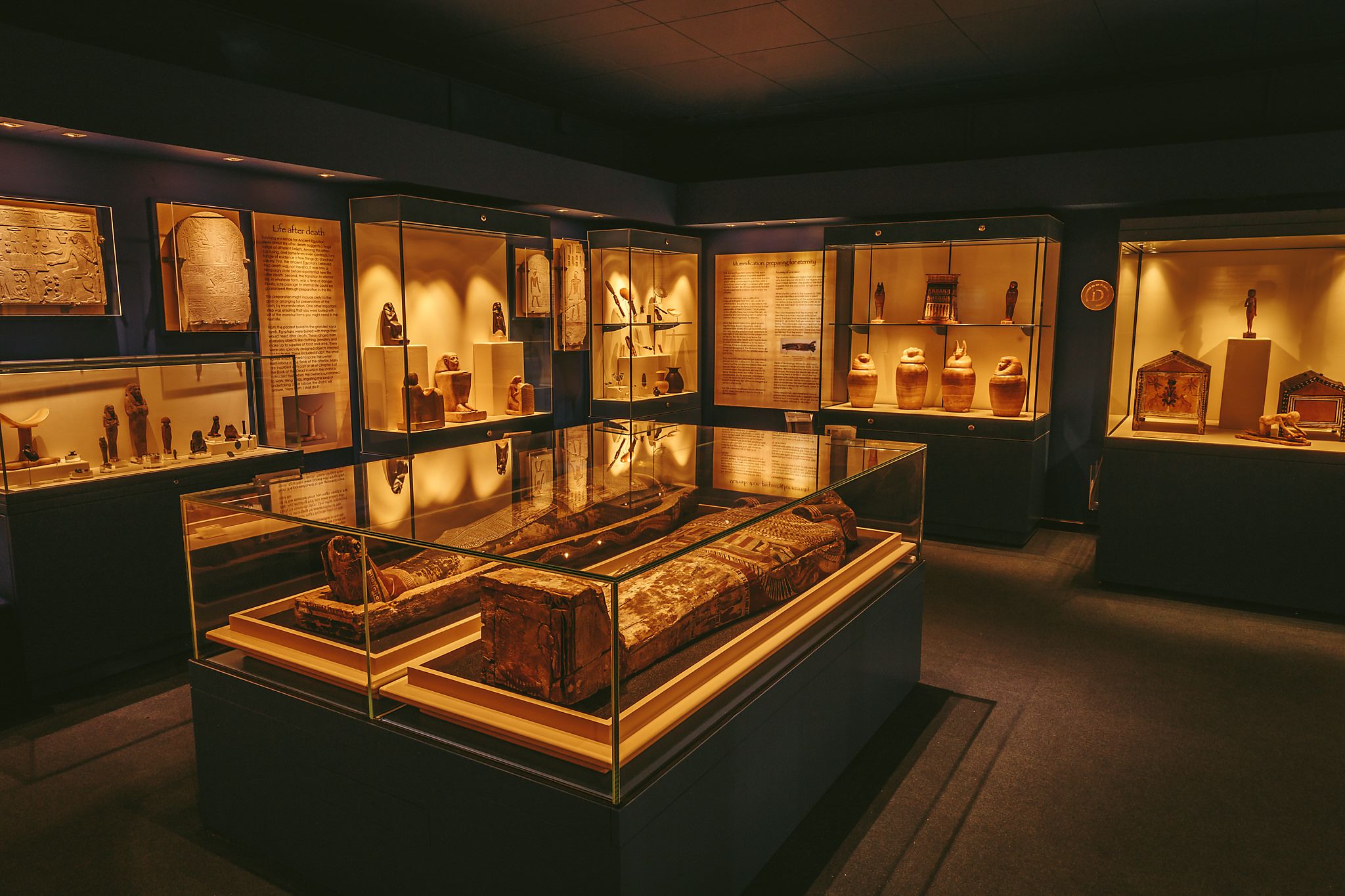
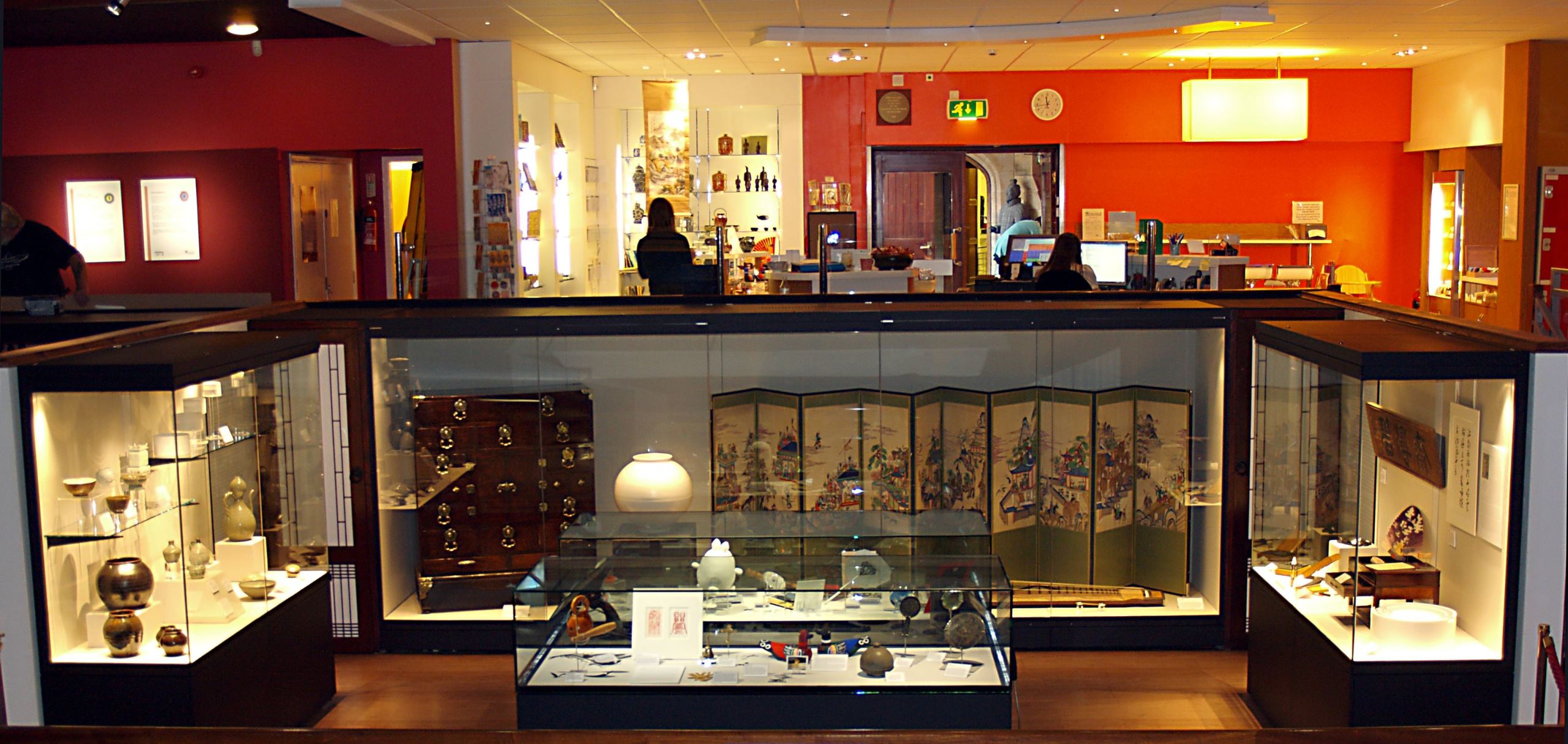
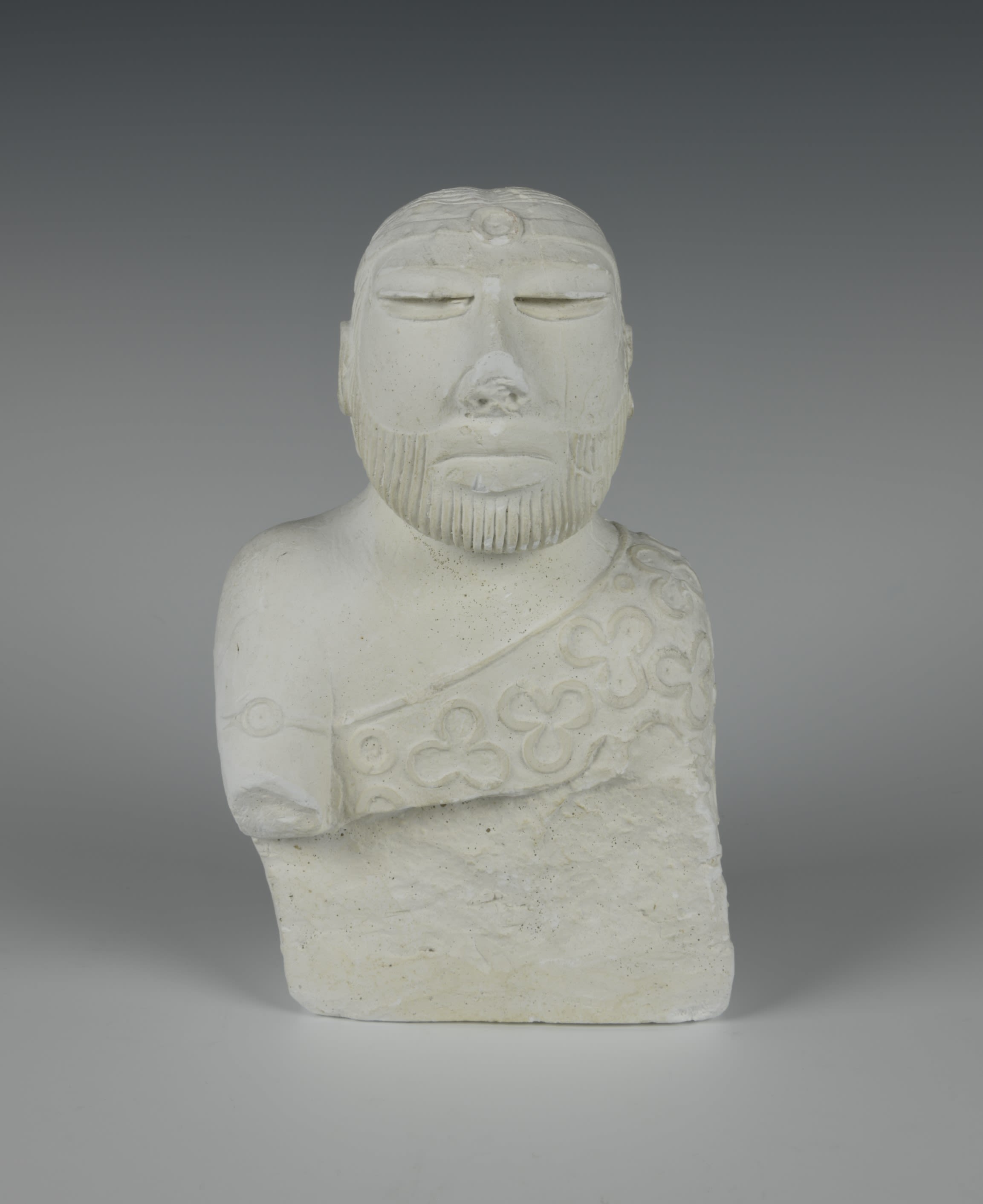
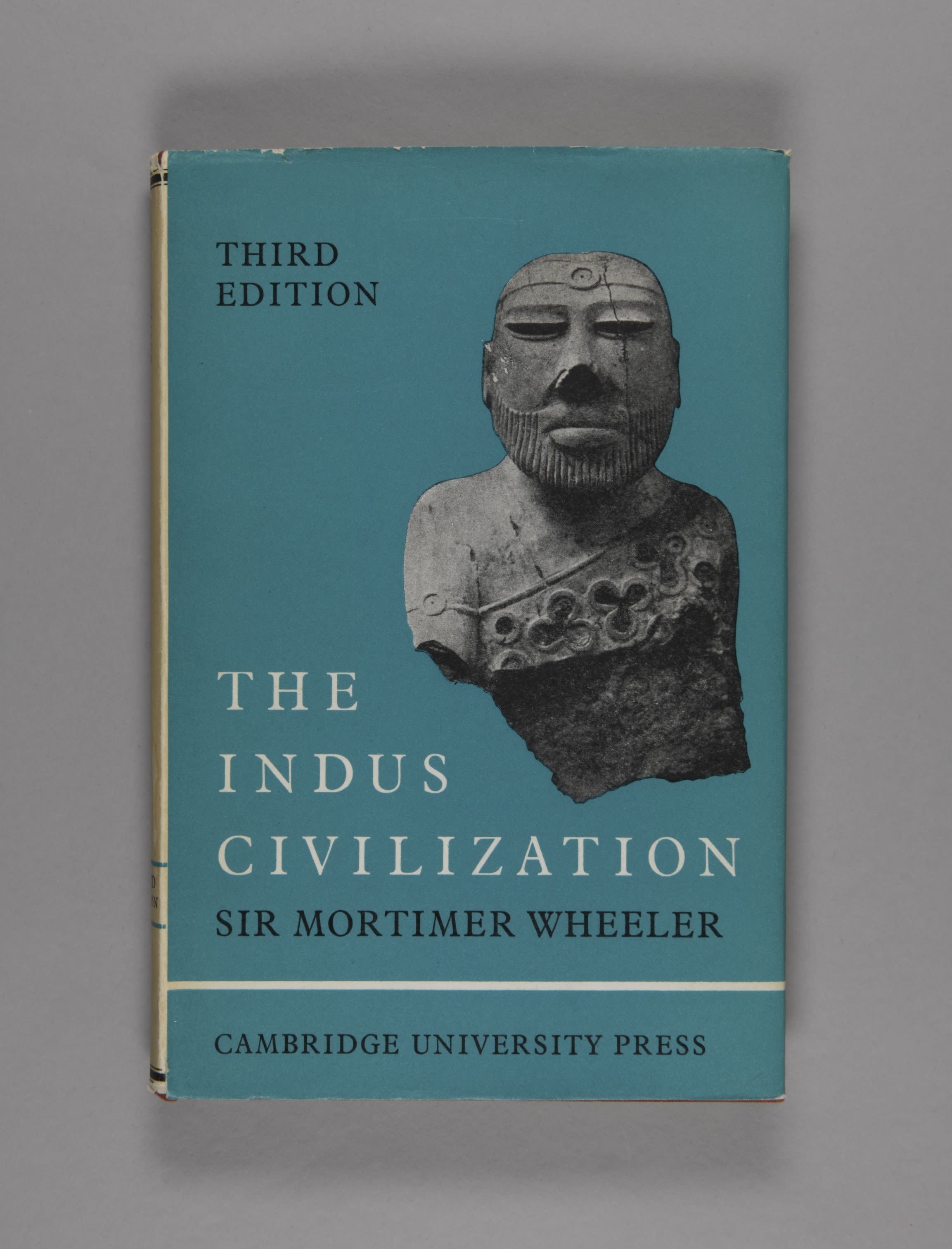
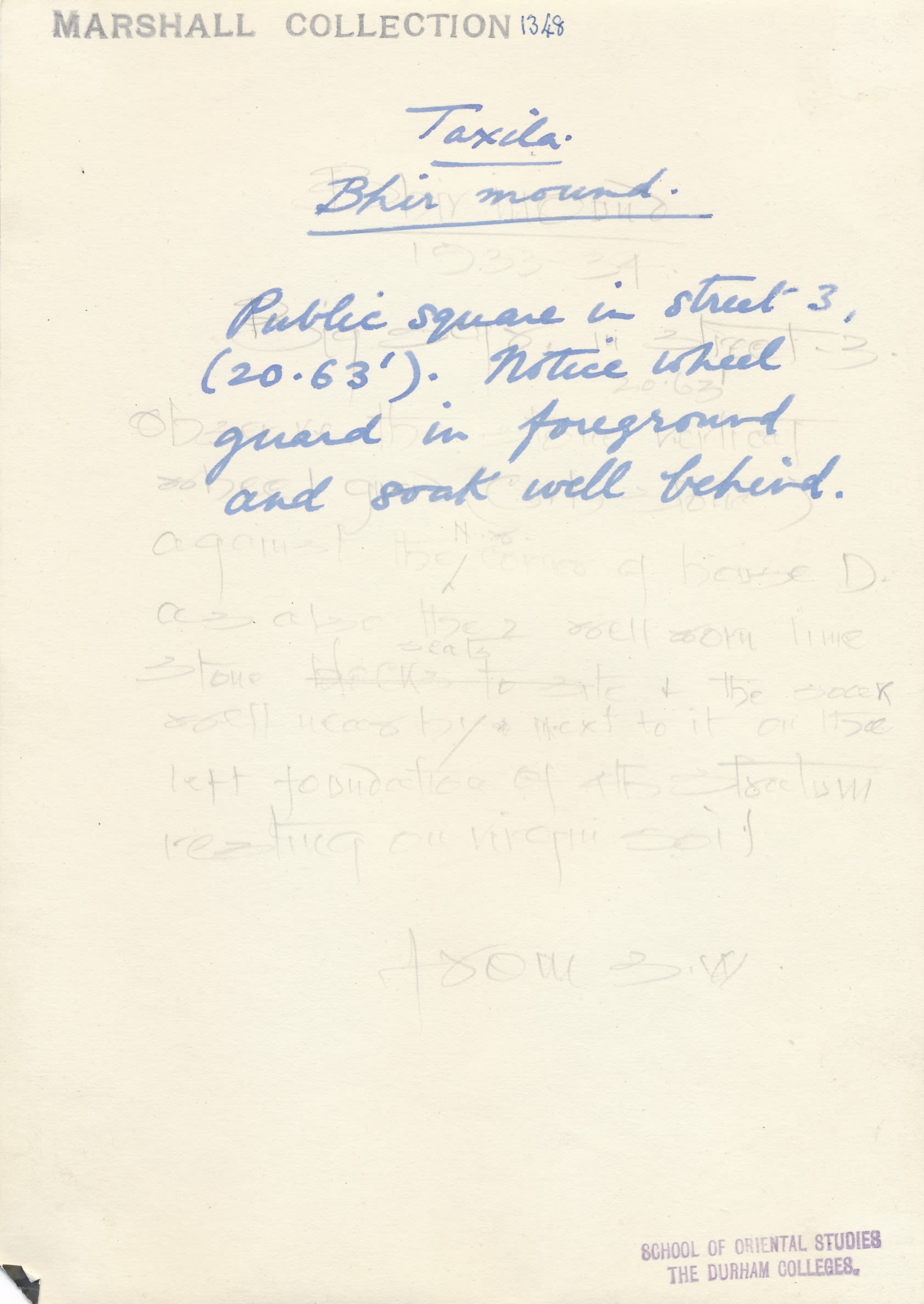
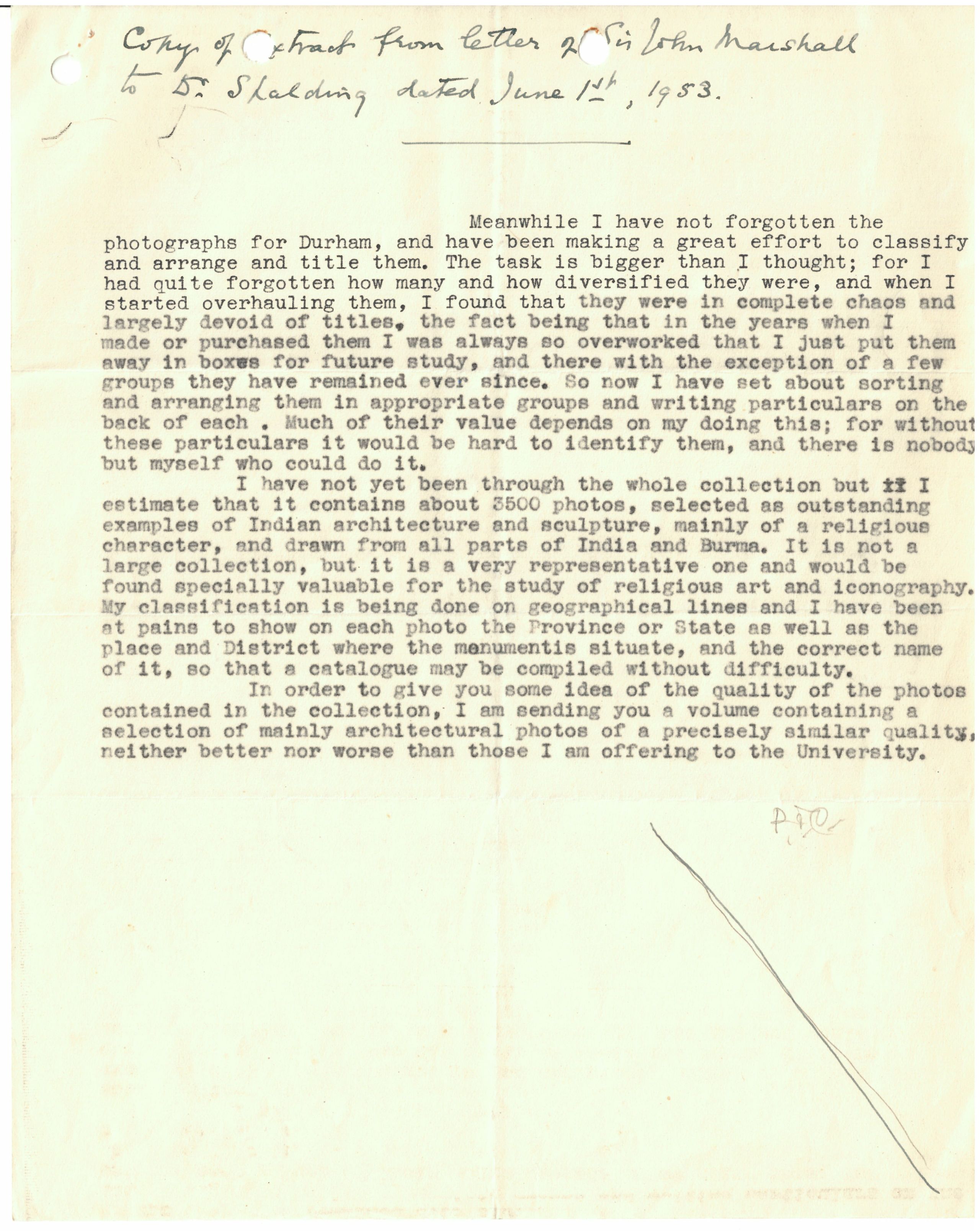
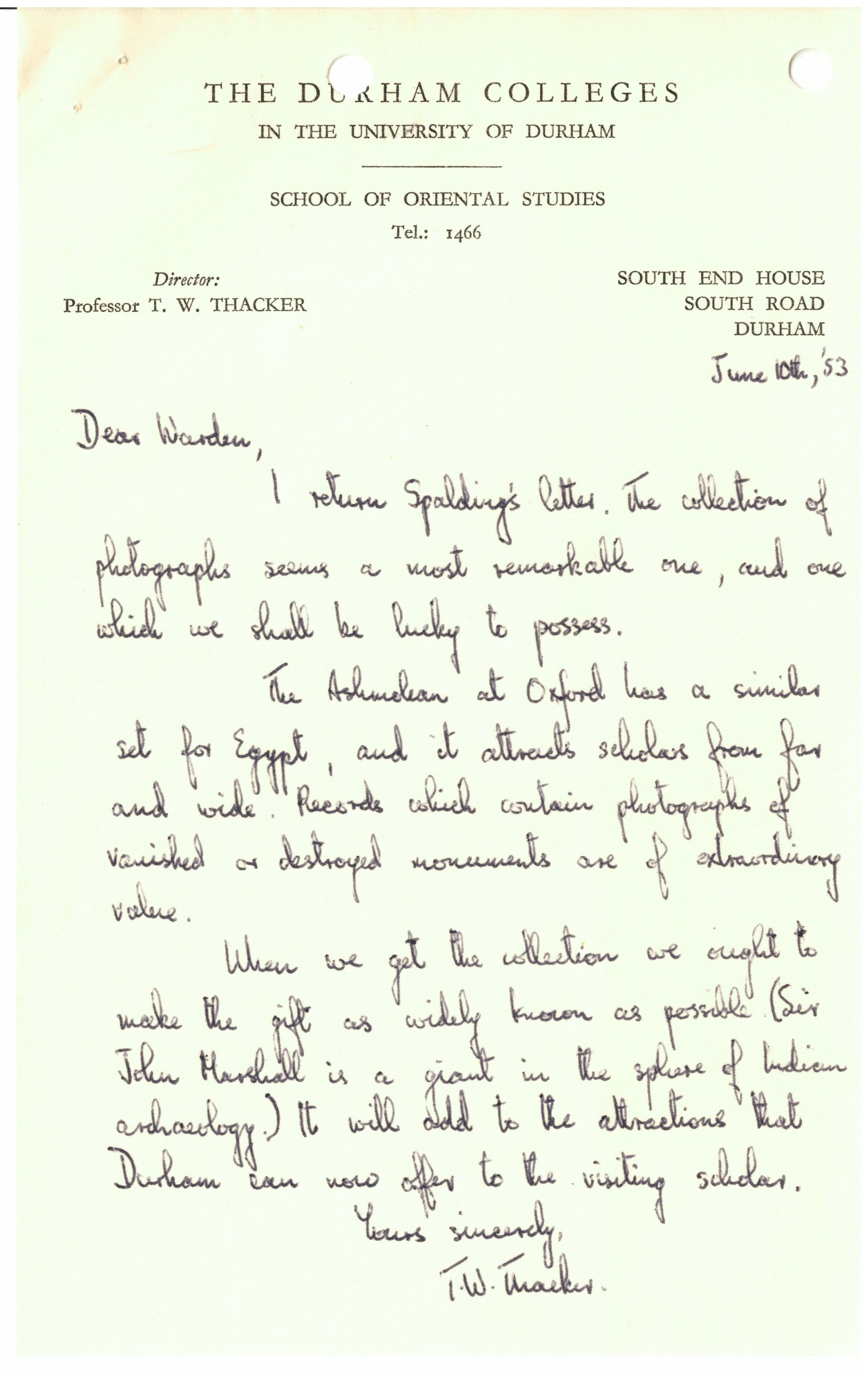
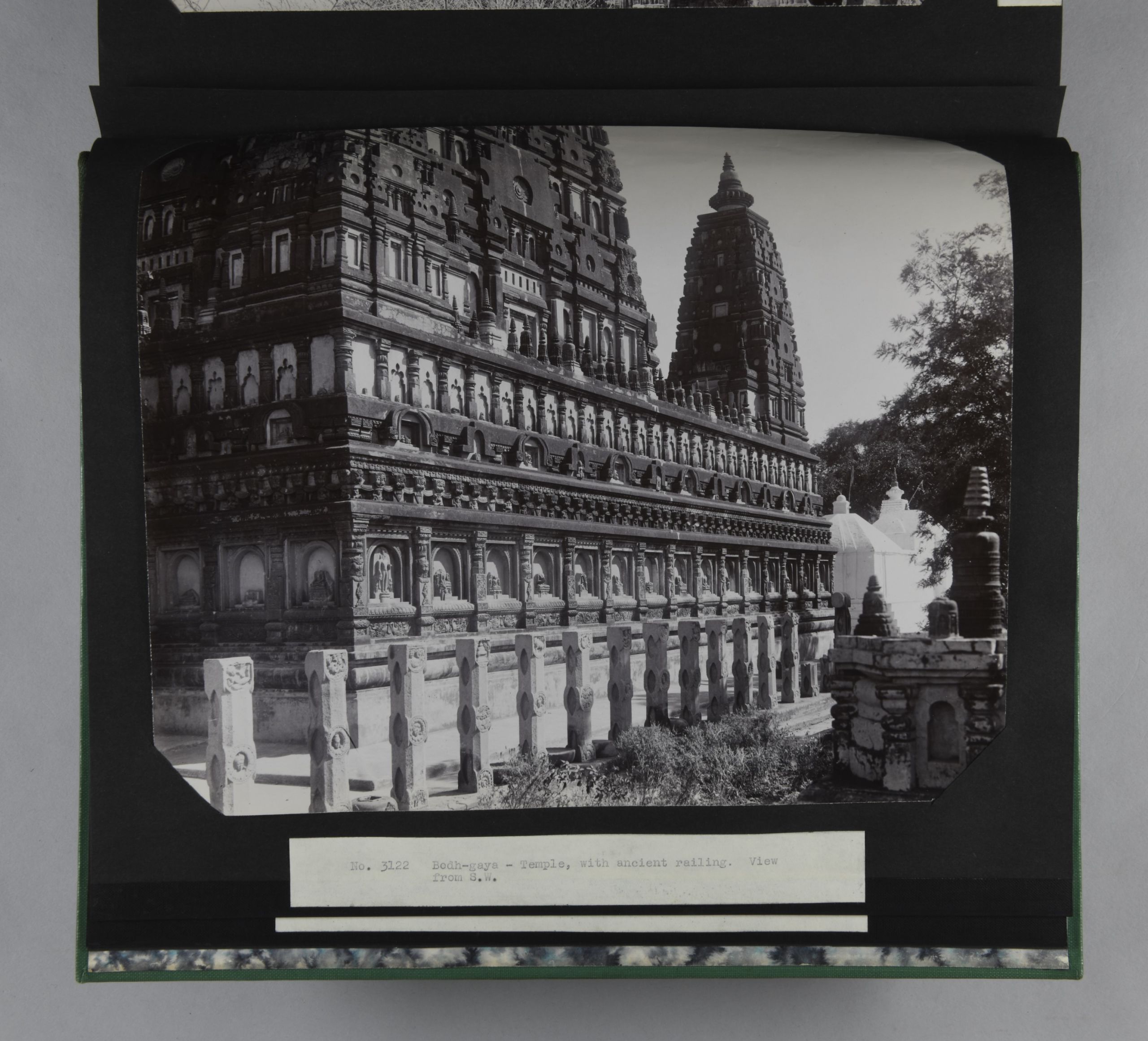
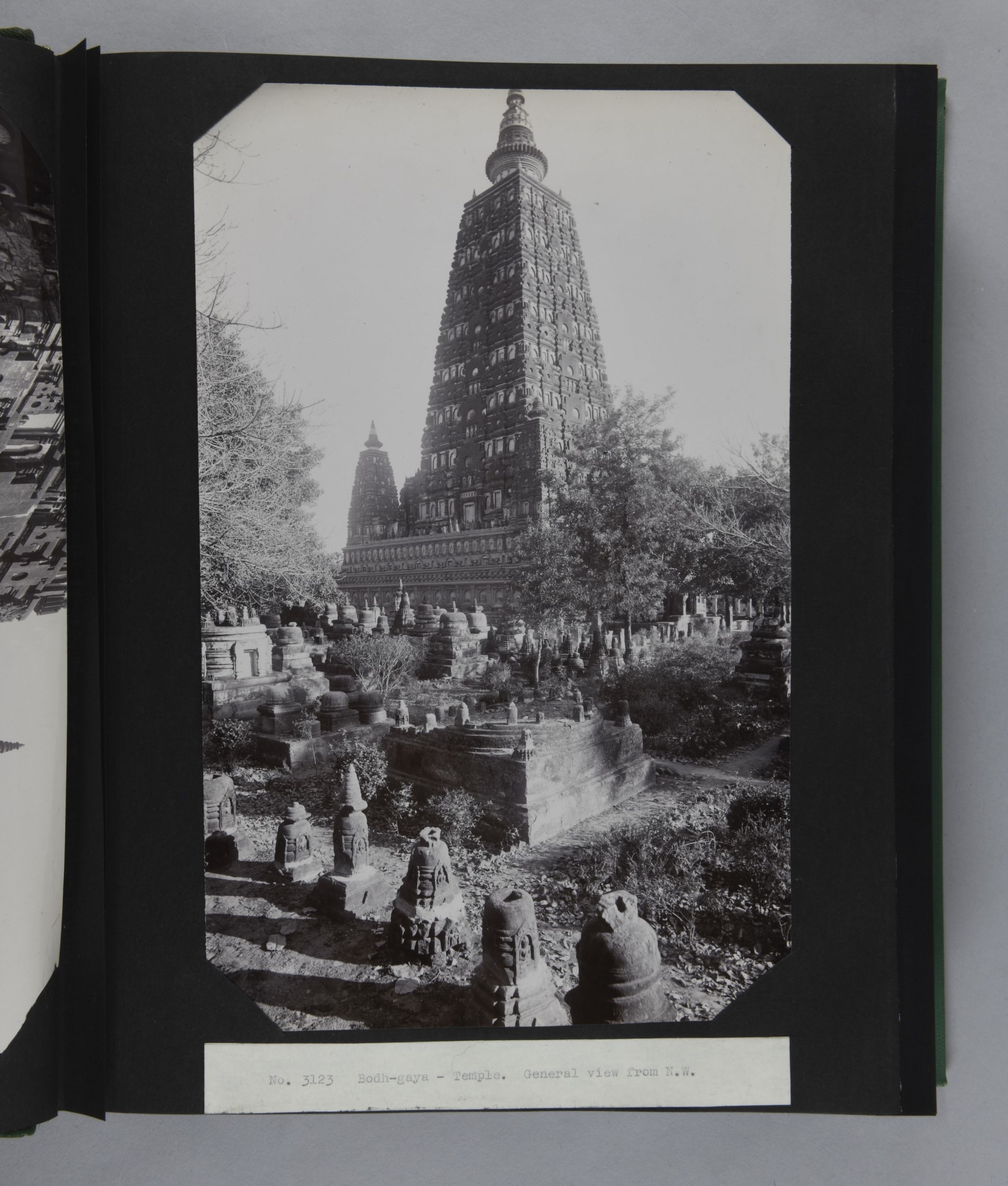

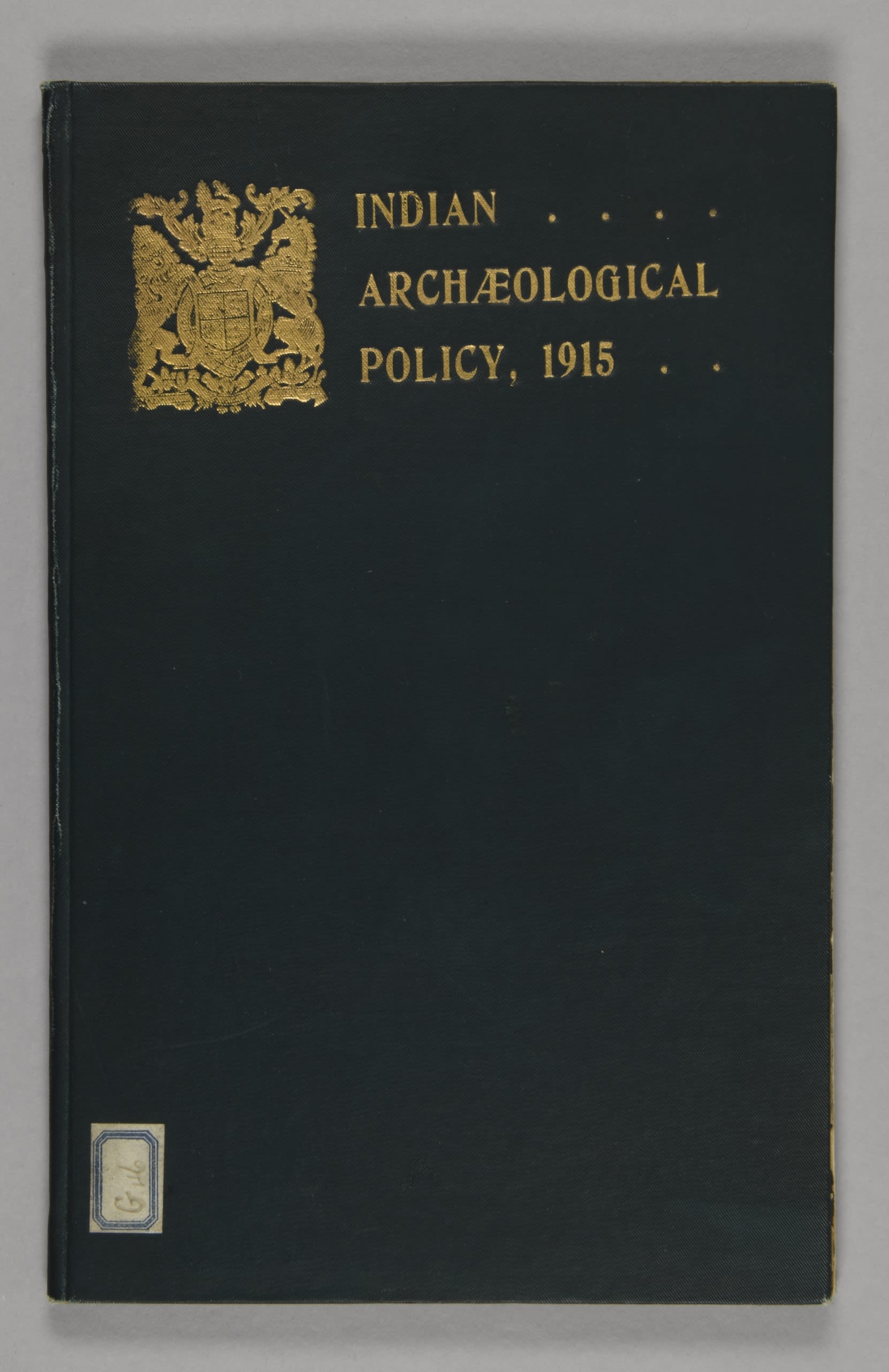

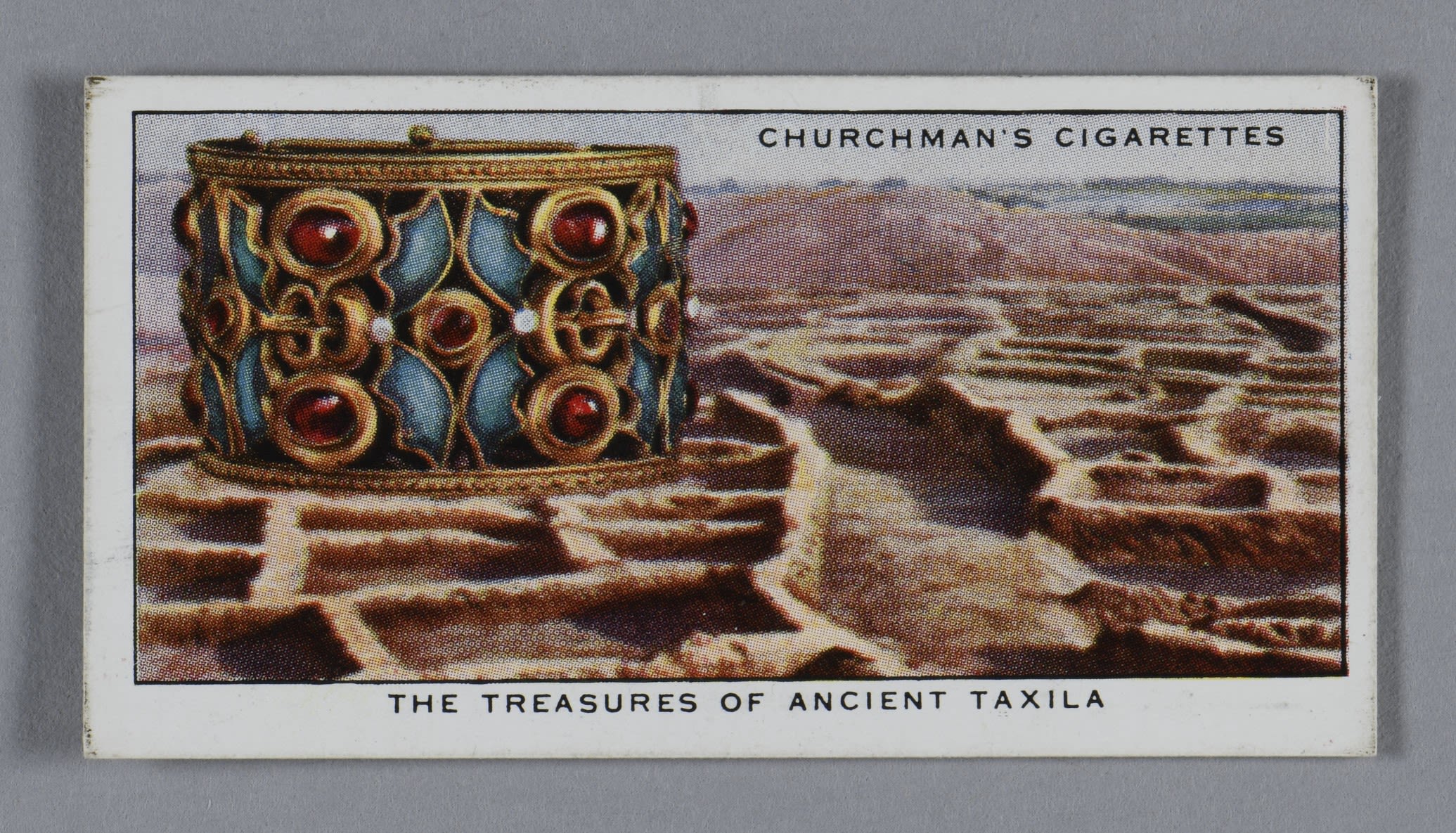

The ‘Priest-King’ | Modern Plaster of Paris cast of the so-called ‘Priest-King’. The original was sculpted from steatite and was discovered in the DK Area of Mohenjo-daro’s lower town. It depicts a bearded figure who wears a headband and has a cloak with trefoil design over the left shoulder. It is one of the most famous objects found at Mohenjo-daro and is thus a popular subject of tourist souvenirs from the site. Modern replica made in 1990s. Pakistan, plaster of Paris. Gift from Prof R Coningham
The ‘Priest-King’ | Modern Plaster of Paris cast of the so-called ‘Priest-King’. The original was sculpted from steatite and was discovered in the DK Area of Mohenjo-daro’s lower town. It depicts a bearded figure who wears a headband and has a cloak with trefoil design over the left shoulder. It is one of the most famous objects found at Mohenjo-daro and is thus a popular subject of tourist souvenirs from the site. Modern replica made in 1990s. Pakistan, plaster of Paris. Gift from Prof R Coningham

The Indus Civilization, by Sir Mortimer Wheeler | The ‘Priest-King’ features on the cover of this volume by Sir Mortimer Wheeler. The rarity of sculpture, and the suggestion that Indus society was controlled by a priestly elite, led Sir Mortimer Wheeler to state that:“The analogues from Egypt and Mesopotamia at least combine to suggest a religious and in particular an astral connotation for the [trefoil] motif, and support the conjecture that the Mohenjo-daro bust may portray a deity or perhaps a priest-king” (Wheeler, The Indus Civilization, 1968, page 87). 1968. United Kingdom. On loan from Durham UNESCO Chair
The Indus Civilization, by Sir Mortimer Wheeler | The ‘Priest-King’ features on the cover of this volume by Sir Mortimer Wheeler. The rarity of sculpture, and the suggestion that Indus society was controlled by a priestly elite, led Sir Mortimer Wheeler to state that:“The analogues from Egypt and Mesopotamia at least combine to suggest a religious and in particular an astral connotation for the [trefoil] motif, and support the conjecture that the Mohenjo-daro bust may portray a deity or perhaps a priest-king” (Wheeler, The Indus Civilization, 1968, page 87). 1968. United Kingdom. On loan from Durham UNESCO Chair

Notes on the Back of A Photograph in the Marshall Collection | Before Sir John Marshall gave his photographic collection to Durham University, he added handwritten notes to the back of each print. This example is a photograph of the Bhir Mound at Taxila. Marshall has overwritten his original notes with details written in pen. The information recorded by Marshall on each print has been vital for modern researchers. Two stamps were added along with a hand written number identifying each image in the collection when the photographs were added to the Oriental Museum’s collections. 1933/34Pakistan, photographic print. DUROM.1957.1.1348
Notes on the Back of A Photograph in the Marshall Collection | Before Sir John Marshall gave his photographic collection to Durham University, he added handwritten notes to the back of each print. This example is a photograph of the Bhir Mound at Taxila. Marshall has overwritten his original notes with details written in pen. The information recorded by Marshall on each print has been vital for modern researchers. Two stamps were added along with a hand written number identifying each image in the collection when the photographs were added to the Oriental Museum’s collections. 1933/34Pakistan, photographic print. DUROM.1957.1.1348

Extract of a letter from Sir John Marshall to Dr and Mrs Spalding, enclosed in correspondence between them and the founder-curator of the Oriental Museum, Professor Thomas Thacker, regarding Marshall’s collection of photographs. 1953
Extract of a letter from Sir John Marshall to Dr and Mrs Spalding, enclosed in correspondence between them and the founder-curator of the Oriental Museum, Professor Thomas Thacker, regarding Marshall’s collection of photographs. 1953

Letter from Professor Thomas Thacker to the Warden of Durham University regarding Marshall’s collection of photographs. 1953
Letter from Professor Thomas Thacker to the Warden of Durham University regarding Marshall’s collection of photographs. 1953

Original Prints Mounted in Albums | When the Marshall Collection arrived in Durham in the 1950s, a set of 60 bespoke albums were created to hold all the images. Each photograph or drawing was mounted on a page and Marshall’s annotations on the back of the image transcribed onto a label beneath the image. The images were grouped geographically. This album focuses on sites and monuments of Gaya District in what was known as the Province of Bihar in India, now Bihar State.
Original Prints Mounted in Albums | When the Marshall Collection arrived in Durham in the 1950s, a set of 60 bespoke albums were created to hold all the images. Each photograph or drawing was mounted on a page and Marshall’s annotations on the back of the image transcribed onto a label beneath the image. The images were grouped geographically. This album focuses on sites and monuments of Gaya District in what was known as the Province of Bihar in India, now Bihar State.

Original Prints Mounted in Albums | The paper in these 1950s albums is acidic and over time will damage the fragile prints. A project is currently underway to move all of the prints to acid-free museum storage for long term preservation. Each print is also being scanned so that it can be accessed digitally and fully catalogued in the museum’s online database. Around half of the collection has been digitised to date.
Original Prints Mounted in Albums | The paper in these 1950s albums is acidic and over time will damage the fragile prints. A project is currently underway to move all of the prints to acid-free museum storage for long term preservation. Each print is also being scanned so that it can be accessed digitally and fully catalogued in the museum’s online database. Around half of the collection has been digitised to date.

Still Digging | The 1958 cover illustration of this Pan Books edition of Still Digging places Sir Mortimer Wheeler in front of a depiction of an archaeological excavation somewhere in South Asia. Similar to the vibrant paperback cover art of the time, the scene portrays Wheeler as described on the back cover - “Archaeologist and Man of Action”. Also describing Wheeler as “Acclaimed Television Personality of the Year”, the publication of Still Digging by Pan Books, a popular paperback publisher, ensured that Wheeler’s views and ideas, as well as discoveries, reached a mass audience. 1958. United Kingdom
Still Digging | The 1958 cover illustration of this Pan Books edition of Still Digging places Sir Mortimer Wheeler in front of a depiction of an archaeological excavation somewhere in South Asia. Similar to the vibrant paperback cover art of the time, the scene portrays Wheeler as described on the back cover - “Archaeologist and Man of Action”. Also describing Wheeler as “Acclaimed Television Personality of the Year”, the publication of Still Digging by Pan Books, a popular paperback publisher, ensured that Wheeler’s views and ideas, as well as discoveries, reached a mass audience. 1958. United Kingdom

Indian Archaeological Policy 1915 | 1916, India
Indian Archaeological Policy 1915 | 1916, India

Indian Archaeological Policy 1915 | This Government policy document contains a lengthy note by Sir John Marshall on the history of Archaeology within British controlled India, how it was developing and how it was organised. Within it, Marshall outlined the major categories of sites and monuments as well as principles of conservation and future conservation needs. 1916, India
Indian Archaeological Policy 1915 | This Government policy document contains a lengthy note by Sir John Marshall on the history of Archaeology within British controlled India, how it was developing and how it was organised. Within it, Marshall outlined the major categories of sites and monuments as well as principles of conservation and future conservation needs. 1916, India

Churchman’s Cigarettes ‘The treasures of Ancient Taxila’ Cigarette Card | Number 37 of 50 in the W.A. & A. Churchman cigarette card collection ‘Treasure Trove’. | Part of the description on the reverse states “In recent years Sir John Marshall has done invaluable work there, and we illustrate the excavations on the Bhir Mound, showing a narrow and winding by-lane and the remains of houses dating from the 3rd and 4th centuries”. The inset illustrates a bracelet of gold inlaid with garnets and turquoise excavated from the site. The presence of Taxila within this set of cards indicates the level of publicity the excavations at Taxila achieved for a wider audience. 1937. United Kingdom
Churchman’s Cigarettes ‘The treasures of Ancient Taxila’ Cigarette Card | Number 37 of 50 in the W.A. & A. Churchman cigarette card collection ‘Treasure Trove’. | Part of the description on the reverse states “In recent years Sir John Marshall has done invaluable work there, and we illustrate the excavations on the Bhir Mound, showing a narrow and winding by-lane and the remains of houses dating from the 3rd and 4th centuries”. The inset illustrates a bracelet of gold inlaid with garnets and turquoise excavated from the site. The presence of Taxila within this set of cards indicates the level of publicity the excavations at Taxila achieved for a wider audience. 1937. United Kingdom












The ‘Priest-King’ | Modern Plaster of Paris cast of the so-called ‘Priest-King’. The original was sculpted from steatite and was discovered in the DK Area of Mohenjo-daro’s lower town. It is one of the most famous objects found at Mohenjo-daro and is thus a popular subject of tourist souvenirs from the site. Modern replica made in 1990s. Pakistan, plaster of Paris. Gift from Prof R Coningham
The ‘Priest-King’ | Modern Plaster of Paris cast of the so-called ‘Priest-King’. The original was sculpted from steatite and was discovered in the DK Area of Mohenjo-daro’s lower town. It is one of the most famous objects found at Mohenjo-daro and is thus a popular subject of tourist souvenirs from the site. Modern replica made in 1990s. Pakistan, plaster of Paris. Gift from Prof R Coningham

The Indus Civilization, by Sir Mortimer Wheeler | The ‘Priest-King’ features on the cover of this book in which Sir Mortimer Wheeler states: “The analogues from Egypt and Mesopotamia at least combine to suggest a religious and in particular an astral connotation for the [trefoil] motif, and support the conjecture that the Mohenjo-daro bust may portray a deity or perhaps a priest-king”. 1968. United Kingdom. Durham UNESCO Chair
The Indus Civilization, by Sir Mortimer Wheeler | The ‘Priest-King’ features on the cover of this book in which Sir Mortimer Wheeler states: “The analogues from Egypt and Mesopotamia at least combine to suggest a religious and in particular an astral connotation for the [trefoil] motif, and support the conjecture that the Mohenjo-daro bust may portray a deity or perhaps a priest-king”. 1968. United Kingdom. Durham UNESCO Chair

Before Marshall gave his photographic collection to Durham University, he added notes to the back of each print. This example is a photograph of the Bhir Mound at Taxila. The information recorded by Marshall on each print has been vital for modern researchers. 1933/1934, Pakistan. DUROM.1957.1.1348
Before Marshall gave his photographic collection to Durham University, he added notes to the back of each print. This example is a photograph of the Bhir Mound at Taxila. The information recorded by Marshall on each print has been vital for modern researchers. 1933/1934, Pakistan. DUROM.1957.1.1348

Extract of a letter from Sir John Marshall to Dr and Mrs Spalding, enclosed in correspondence between them and the founder-curator of the Oriental Museum, Professor Thomas Thacker, regarding Marshall’s collection of photographs. 1953
Extract of a letter from Sir John Marshall to Dr and Mrs Spalding, enclosed in correspondence between them and the founder-curator of the Oriental Museum, Professor Thomas Thacker, regarding Marshall’s collection of photographs. 1953

Letter from Professor Thomas Thacker to the Warden of Durham University regarding Marshall’s collection of photographs. 1953
Letter from Professor Thomas Thacker to the Warden of Durham University regarding Marshall’s collection of photographs. 1953

Original Prints Mounted in Albums | When the Marshall Collection arrived in Durham in the 1950s, a set of 60 bespoke albums were created to hold all the images. Each photograph or drawing was mounted on a page and Marshall’s annotations on the back of the image transcribed onto a label beneath the image. The images were grouped geographically. This album focuses on sites and monuments of Gaya District in what was known as the Province of Bihar in India, now Bihar State.
Original Prints Mounted in Albums | When the Marshall Collection arrived in Durham in the 1950s, a set of 60 bespoke albums were created to hold all the images. Each photograph or drawing was mounted on a page and Marshall’s annotations on the back of the image transcribed onto a label beneath the image. The images were grouped geographically. This album focuses on sites and monuments of Gaya District in what was known as the Province of Bihar in India, now Bihar State.

Original Prints Mounted in Albums | The paper in these 1950s albums is acidic and over time will damage the fragile prints. A project is currently underway to move all of the prints to acid-free museum storage for long term preservation. Each print is also being scanned so that it can be accessed digitally and fully catalogued in the museum’s online database. Around half of the collection has been digitised to date.
Original Prints Mounted in Albums | The paper in these 1950s albums is acidic and over time will damage the fragile prints. A project is currently underway to move all of the prints to acid-free museum storage for long term preservation. Each print is also being scanned so that it can be accessed digitally and fully catalogued in the museum’s online database. Around half of the collection has been digitised to date.

Still Digging | This cover illustration shows Sir Mortimer Wheeler in front of an archaeological excavation somewhere in South Asia. The scene portrays Wheeler as described on the back cover - “Archaeologist and Man of Action”. The publication of Still Digging by Pan Books, a popular paperback publisher, ensured that Wheeler’s views and ideas, as well as discoveries, reached a mass audience. 1958. United Kingdom
Still Digging | This cover illustration shows Sir Mortimer Wheeler in front of an archaeological excavation somewhere in South Asia. The scene portrays Wheeler as described on the back cover - “Archaeologist and Man of Action”. The publication of Still Digging by Pan Books, a popular paperback publisher, ensured that Wheeler’s views and ideas, as well as discoveries, reached a mass audience. 1958. United Kingdom

Indian Archaeological Policy 1915 | 1916, India
Indian Archaeological Policy 1915 | 1916, India

Indian Archaeological Policy 1915 | This Government policy document contains a lengthy note by Sir John Marshall on the history of Archaeology within British controlled India, how it was developing and how it was organised. Within it, Marshall outlined the major categories of sites and monuments as well as principles of conservation and future conservation needs. 1916, India
Indian Archaeological Policy 1915 | This Government policy document contains a lengthy note by Sir John Marshall on the history of Archaeology within British controlled India, how it was developing and how it was organised. Within it, Marshall outlined the major categories of sites and monuments as well as principles of conservation and future conservation needs. 1916, India

Churchman’s Cigarettes ‘The treasures of Ancient Taxila’ Cigarette Card | Number 37 of 50 in the W.A. & A. Churchman cigarette card collection ‘Treasure Trove’. | Part of the description on the reverse states “In recent years Sir John Marshall has done invaluable work there, and we illustrate the excavations on the Bhir Mound, showing a narrow and winding by-lane and the remains of houses dating from the 3rd and 4th centuries”. The inset illustrates a bracelet of gold inlaid with garnets and turquoise excavated from the site. The presence of Taxila within this set of cards indicates the level of publicity the excavations at Taxila achieved for a wider audience. 1937. United Kingdom
Churchman’s Cigarettes ‘The treasures of Ancient Taxila’ Cigarette Card | Number 37 of 50 in the W.A. & A. Churchman cigarette card collection ‘Treasure Trove’. | Part of the description on the reverse states “In recent years Sir John Marshall has done invaluable work there, and we illustrate the excavations on the Bhir Mound, showing a narrow and winding by-lane and the remains of houses dating from the 3rd and 4th centuries”. The inset illustrates a bracelet of gold inlaid with garnets and turquoise excavated from the site. The presence of Taxila within this set of cards indicates the level of publicity the excavations at Taxila achieved for a wider audience. 1937. United Kingdom
Visions of a Discipline:
Archaeology, Photography and Colonialism

Marshall’s remarkable photographic collection not only documents explorations and discoveries at Taxila, but also provides insights into the development of archaeology as a discipline in the early 20th century and Colonial perceptions of South Asia.
Photographs are not entirely objective depictions, and meaning can be created through an image’s composition. It has been suggested that some of the earliest photography in South Asia followed a picturesque tradition borrowed from European landscape painting. Following Romantic conventions of depicting ruins, these images have been interpreted as portraying a ‘decaying and neglected civilisation’ in need of ‘rescue’ by a European imperial power.
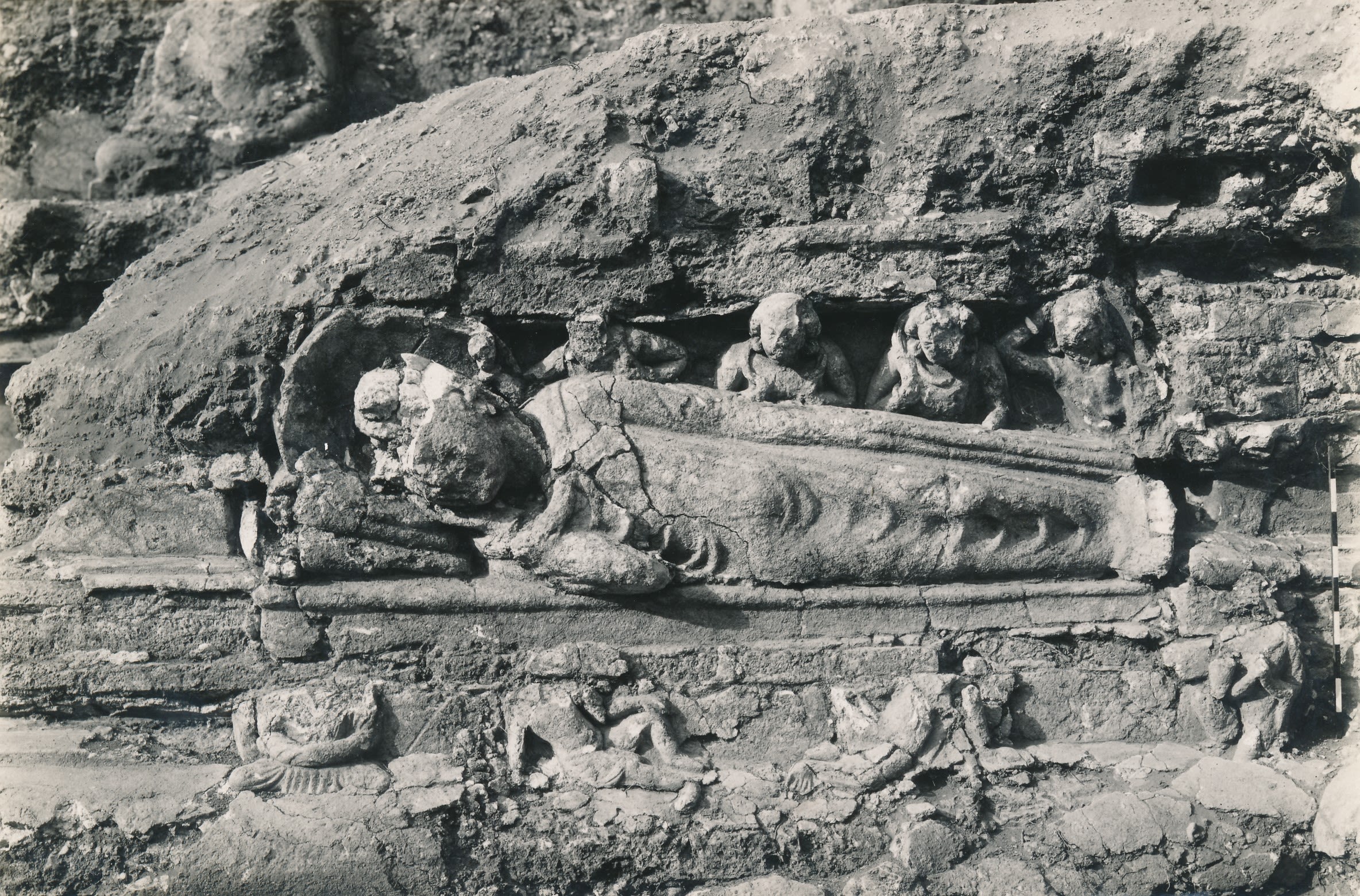
Stucco of the Buddha’s mahaparinirvana or ‘Great Passing Away’, on the Main Stupa at the Bhamala, Taxila, taken in 1930/1931, before conservation. (c.4th-5th century CE) Sir John Marshall Collection, given by Dr and Mrs Spalding. DUROM.1957.1.1314
The professionalisation of archaeological investigations in South Asia during the later nineteenth century prompted a move towards portraying ‘truthful’ and ‘accurate’ images of scientific rigour and archaeological ‘facts’. Marshall is credited with modernising archaeological methods in Colonial South Asia, developing programmes for cataloguing and conserving archaeological discoveries, and undertaking systematic excavations.
“The conservation notes of Archaeological Officers should be accompanied by representative photographs showing the condition of the monument from all points of view before its repair is taken in hand, and they should include full particulars (illustrated as a rule by sketches or scale drawings)... No work is to be put in hand without such particulars.”
Marshall, Conservation Manual (1923: 8)
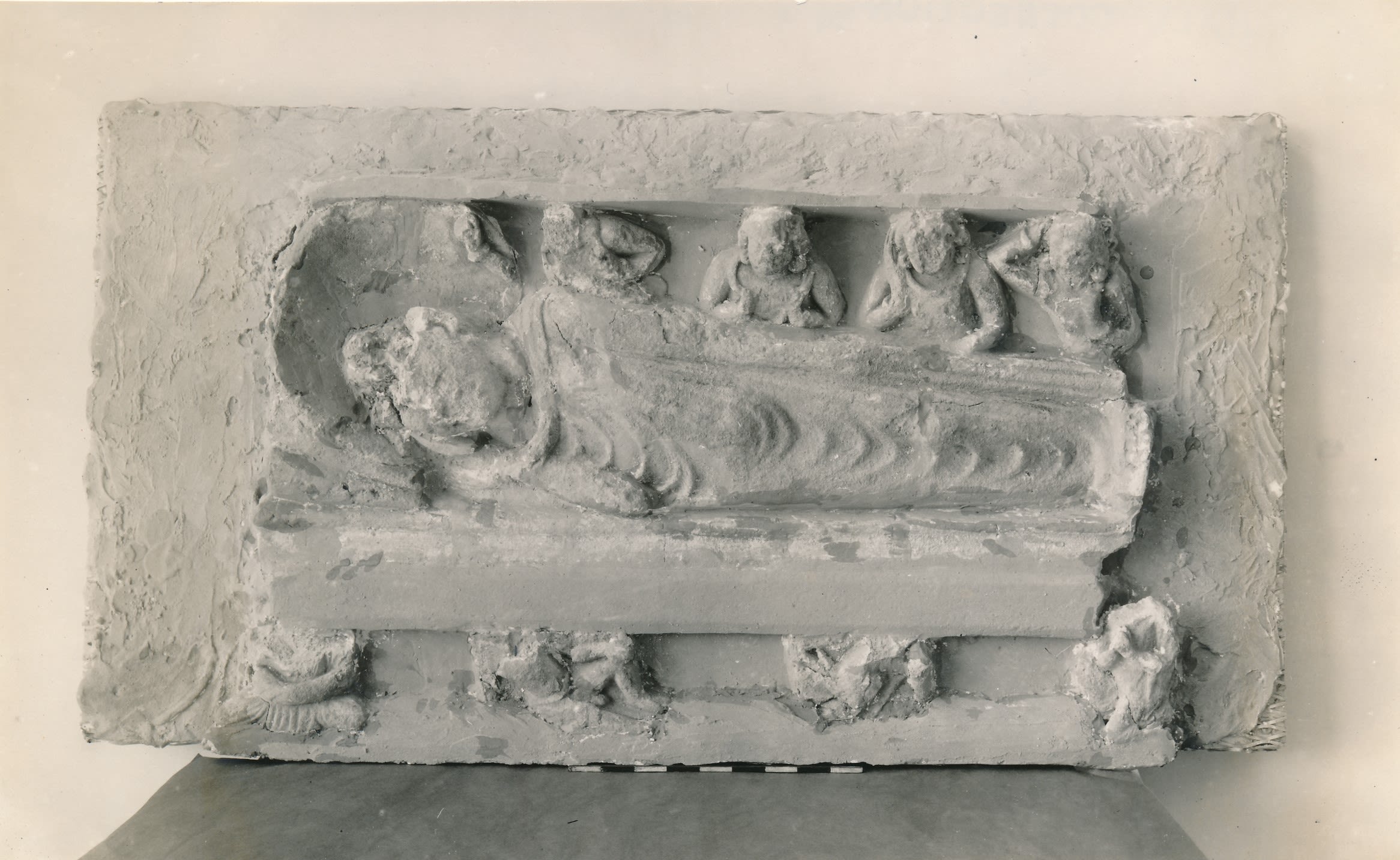
The same sculpture, shown after its conservation, 1930/1931. (4th-5th century CE) Sir John Marshall Collection, given by Dr and Mrs Spalding. DUROM.1957.1.1315
Marshall made it mandatory for Archaeological Officers to take multiple photographic images showing the condition of a monument from all points of view prior to embarking on any conservation and repair. Excavation photographs also began to use scales to create objectivity rather than artistic projections.
Some scholars, however, believe that the development of ‘scientific’ visual imagery was in itself culturally biased. They argue that such images were designed to reaffirm imbalanced power relationships, with archaeological knowledge being created and curated by British officials prior to being presented to Colonial subjects.

Stucco of the Buddha’s mahaparinirvana or ‘Great Passing Away’, on the Main Stupa at the Bhamala, Taxila, taken in 1930/1931, before conservation. (c.4th-5th century CE) Sir John Marshall Collection, given by Dr and Mrs Spalding. DUROM.1957.1.1314
Stucco of the Buddha’s mahaparinirvana or ‘Great Passing Away’, on the Main Stupa at the Bhamala, Taxila, taken in 1930/1931, before conservation. (c.4th-5th century CE) Sir John Marshall Collection, given by Dr and Mrs Spalding. DUROM.1957.1.1314

The same sculpture, shown after its conservation, 1930/1931. (4th-5th century CE) Sir John Marshall Collection, given by Dr and Mrs Spalding. DUROM.1957.1.1315
The same sculpture, shown after its conservation, 1930/1931. (4th-5th century CE) Sir John Marshall Collection, given by Dr and Mrs Spalding. DUROM.1957.1.1315

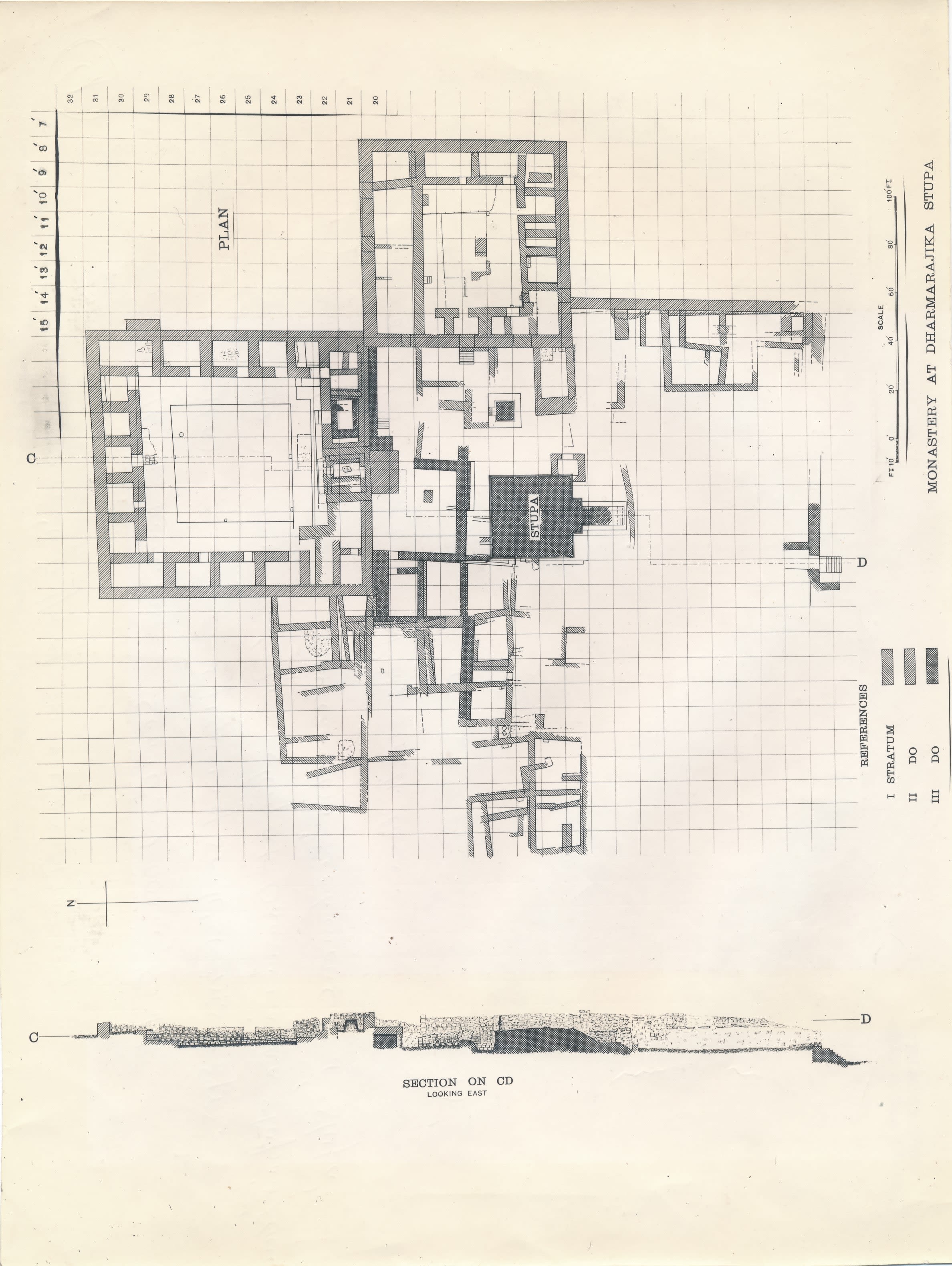

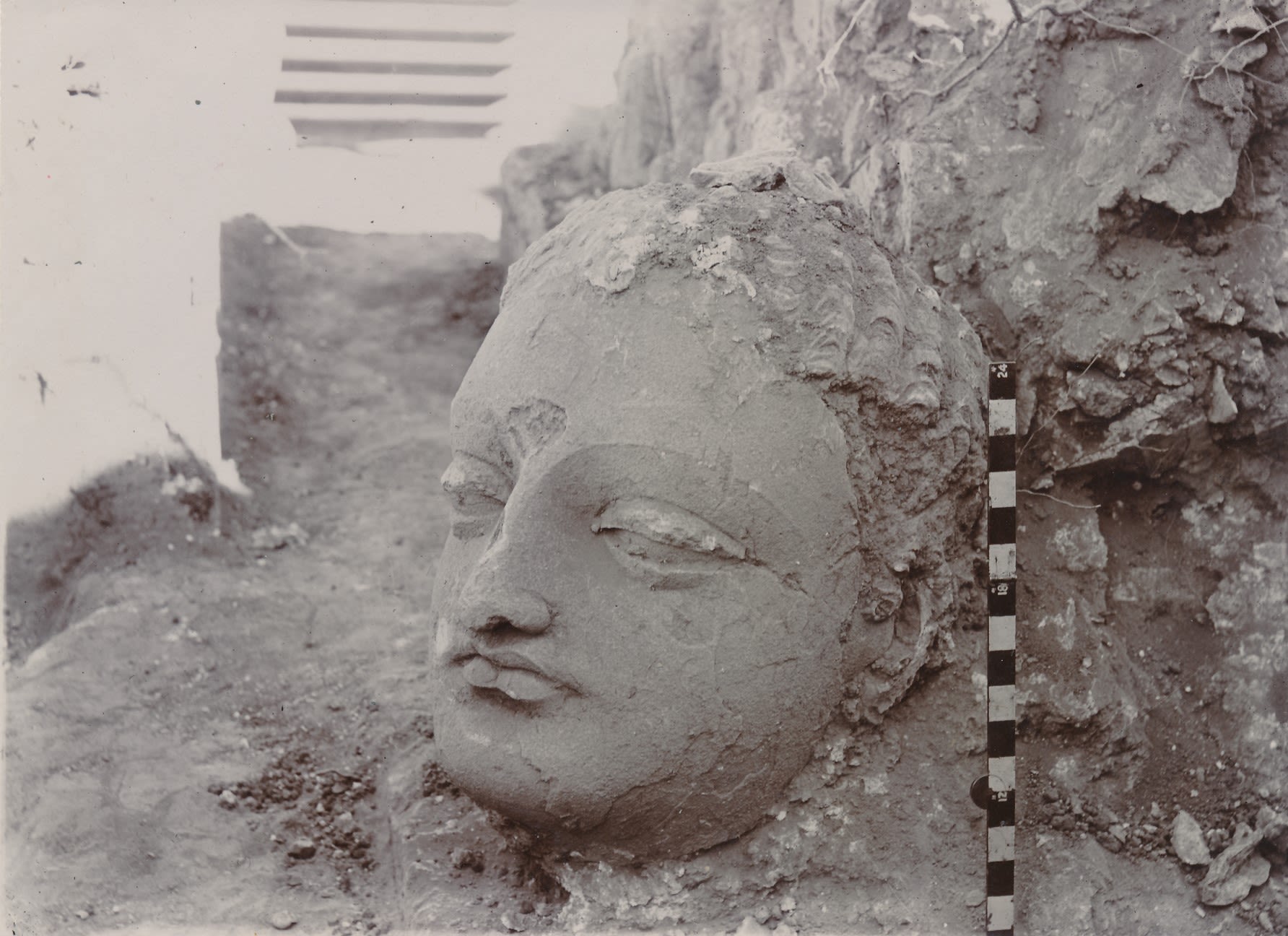

Hindu Temples at Bindrabund on the River Jumna, Thomas Daniell (1749-1840 CE) | Hand-coloured aquatint, India, Uttah Pradesh, Brindaban (Vrindavan) 1795. The 17th century CE Madan Mohan Temple at Vrindavan (Bindrabund), engraved by Thomas Daniell as part of his published collection ‘Oriental Scenery’. Anonymous, Loan
Hindu Temples at Bindrabund on the River Jumna, Thomas Daniell (1749-1840 CE) | Hand-coloured aquatint, India, Uttah Pradesh, Brindaban (Vrindavan) 1795. The 17th century CE Madan Mohan Temple at Vrindavan (Bindrabund), engraved by Thomas Daniell as part of his published collection ‘Oriental Scenery’. Anonymous, Loan

Detailed plan and section drawing of Monastic Courts A, J and H at Dharmarajika, Taxila, after partial clearing. (c.1st-7th century CE) Sir John Marshall Collection, given by Dr and Mrs Spalding. DUROM.1957.1.1453
Detailed plan and section drawing of Monastic Courts A, J and H at Dharmarajika, Taxila, after partial clearing. (c.1st-7th century CE) Sir John Marshall Collection, given by Dr and Mrs Spalding. DUROM.1957.1.1453

Clearing soil and rubble from monastic cells during Marshall’s excavations at the Kunala Monastery on Sirkap’s acropolis, Taxila, 1926/1927. (c.1st century BCE-5th centuries CE) Sir John Marshall Collection, given by Dr and Mrs Spalding. DUROM.1957.1.1674
Clearing soil and rubble from monastic cells during Marshall’s excavations at the Kunala Monastery on Sirkap’s acropolis, Taxila, 1926/1927. (c.1st century BCE-5th centuries CE) Sir John Marshall Collection, given by Dr and Mrs Spalding. DUROM.1957.1.1674

Detail of stucco Buddha head, photographed with a scale, during Marshall’s excavations at the Jaulian Monastery, Taxila, 1916/1917. (c.2nd-5th century CE) Sir John Marshall Collection, given by Dr and Mrs Spalding. DUROM.1957.1.1554
Detail of stucco Buddha head, photographed with a scale, during Marshall’s excavations at the Jaulian Monastery, Taxila, 1916/1917. (c.2nd-5th century CE) Sir John Marshall Collection, given by Dr and Mrs Spalding. DUROM.1957.1.1554
Taxila:
From Prehistory to the Present

Taxila is famed for its three outstandingly preserved, yet distinctly different, cities. The characteristics of these consecutive cities reflect the intermingling of varied communities throughout the site’s long history.
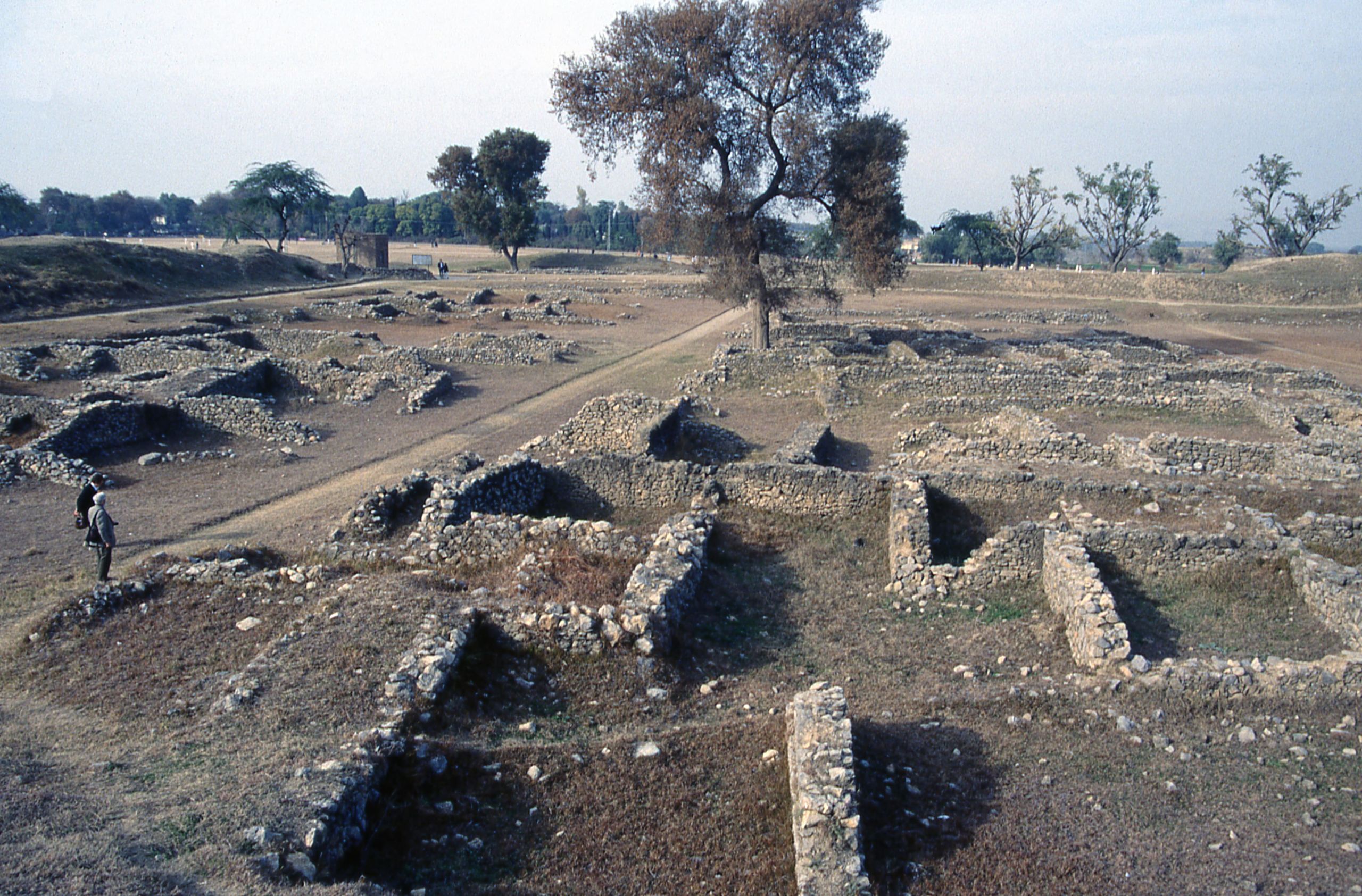
Pakistan, Punjab, Taxila, 1993. Conserved structures of the Bhir Mound, Taxila. (c.5th century BCE-1st century CE) Courtesy of Durham UNESCO Chair
The earliest city, the Bhir Mound (5th century BCE - 1st century CE), lacked defensive walls and was irregular in layout. Its successor, Sirkap (2nd century BCE - 2nd century CE), drew inspiration from Hellenistic traditions and took the form of a walled city with a regular street layout and acropolis.
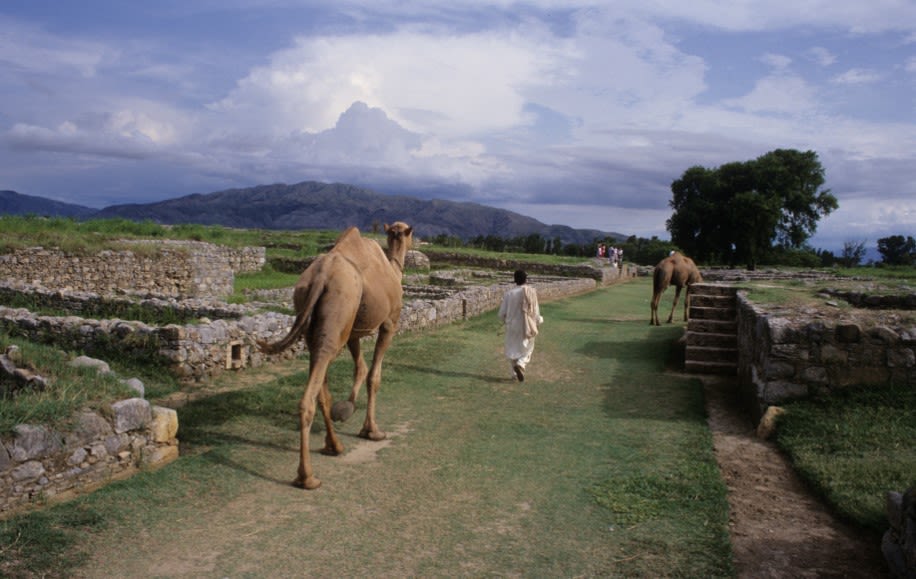
Pakistan, Punjab, Taxila, 1999. Camels being herded through the conserved streets of Sirkap, Taxila. (c. 2nd century BCE—2nd century CE) Courtesy of Durham UNESCO Chair
Taxila’s last monumental complex, Sirsukh (2nd - 3rd century CE), comprised a largely empty rectangular compound, surrounded by walls with rounded bastions, indicating Central Asian connections to some scholars.
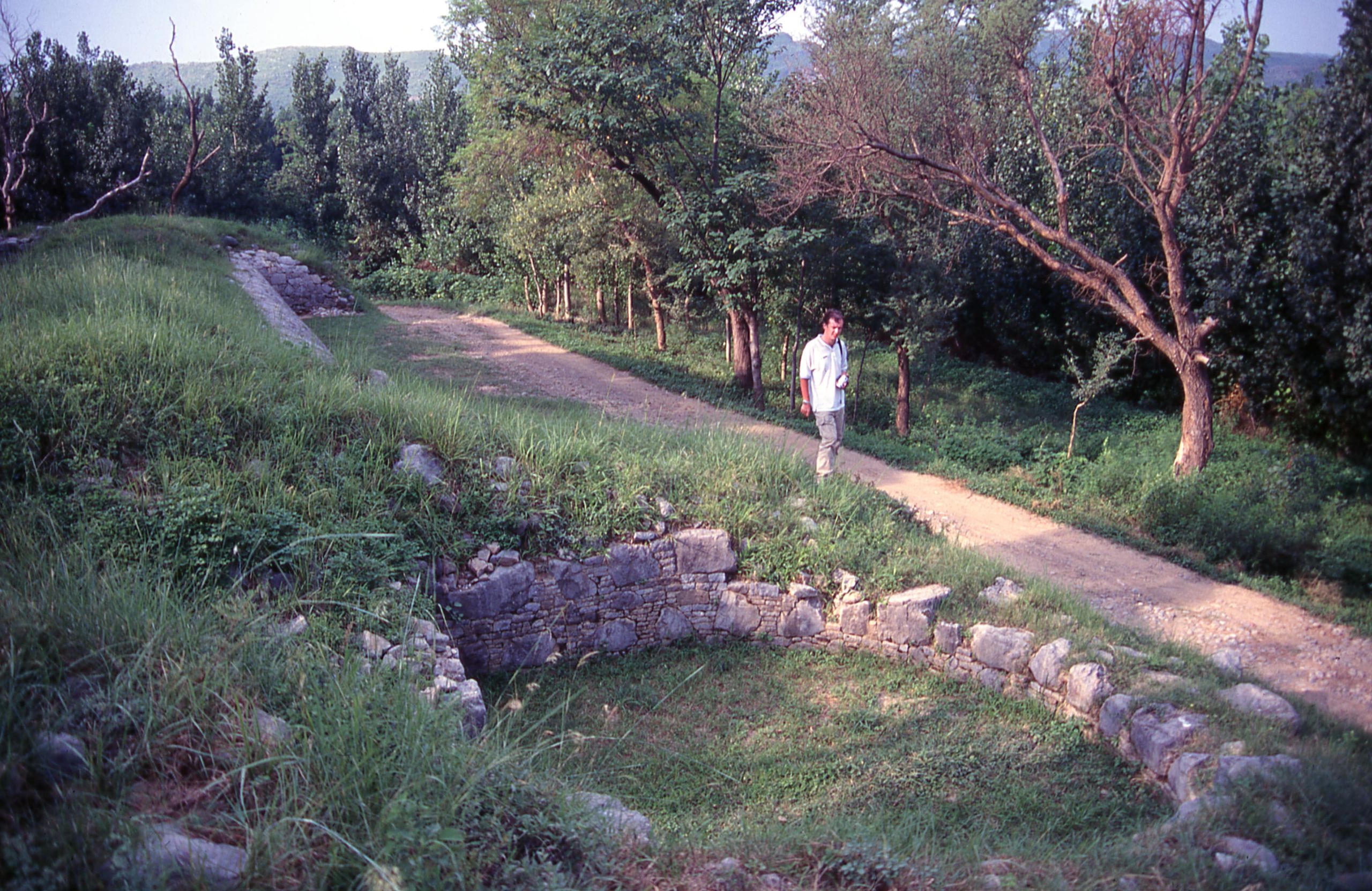
Pakistan, Punjab, Taxila, 1998. Rounded, or stirrup, bastions on the city wall at Sirsukh, Taxila. (c. 2nd—5th century CE) Courtesy of Durham UNESCO Chair
In the countryside beyond the urban settlements, Taxila became a major seat of Buddhist learning. Reaching a peak by the second century CE, Taxila’s monasteries hosted some of the first iconic representations of the Buddha, which mixed South Asian traditions with Greco-Roman artistic styles.
Research since Marshall’s time has revealed a much longer sequence at Taxila. For example, Muhammad Abdul Halim’s excavations at Sarai Khola indicated that early food producers were the first to permanently settle the Valley. In contrast with Marshall’s reliance of external Persian influences for the city’s origins, Professor Ahmad Hasan Dani suggested that its earliest urban development was on the Hathial Mound centuries earlier at the beginning of the first millennium BCE, pushing back Taxila’s settlement history into the Chalcolithic and earlier.
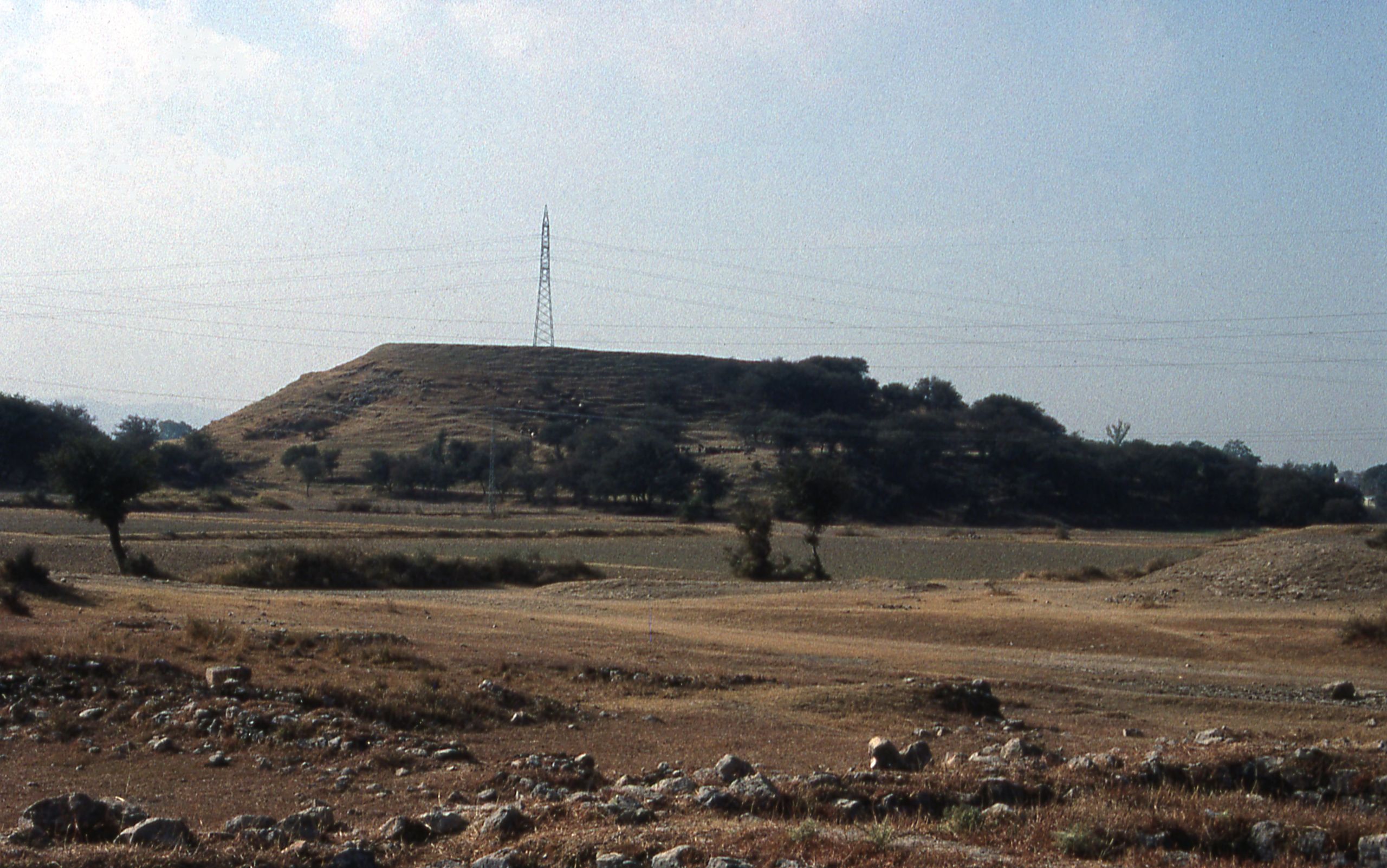
Pakistan, Punjab, Taxila, 1993. View towards one of Taxila’s oldest towns on the Hathial Mound, Taxila. (c.11th—5th century BCE) Courtesy of Durham UNESCO Chair
The Valley’s crucial location beside the Grand Trunk Road later saw the Ghaznavids (977-1186 CE) occupation of the fortress at Giri, while the Mughals established a garden and way station at Wah in the sixteenth century CE.
Protected by the Antiquities Act, passed by the Parliament of the Islamic Republic of Pakistan in 1975, the Valley of Taxila was inscribed on UNESCO’s list of World Heritage Sites in 1980.

Pakistan, Punjab, Taxila, 1993. Conserved structures of the Bhir Mound, Taxila. (c.5th century BCE-1st century CE) Courtesy of Durham UNESCO Chair
Pakistan, Punjab, Taxila, 1993. Conserved structures of the Bhir Mound, Taxila. (c.5th century BCE-1st century CE) Courtesy of Durham UNESCO Chair

Pakistan, Punjab, Taxila, 1999. Camels being herded through the conserved streets of Sirkap, Taxila. (c. 2nd century BCE—2nd century CE) Courtesy of Durham UNESCO Chair
Pakistan, Punjab, Taxila, 1999. Camels being herded through the conserved streets of Sirkap, Taxila. (c. 2nd century BCE—2nd century CE) Courtesy of Durham UNESCO Chair

Pakistan, Punjab, Taxila, 1998. Rounded, or stirrup, bastions on the city wall at Sirsukh, Taxila. (c. 2nd—5th century CE) Courtesy of Durham UNESCO Chair
Pakistan, Punjab, Taxila, 1998. Rounded, or stirrup, bastions on the city wall at Sirsukh, Taxila. (c. 2nd—5th century CE) Courtesy of Durham UNESCO Chair

Pakistan, Punjab, Taxila, 1993. View towards one of Taxila’s oldest towns on the Hathial Mound, Taxila. (c.11th—5th century BCE) Courtesy of Durham UNESCO Chair
Pakistan, Punjab, Taxila, 1993. View towards one of Taxila’s oldest towns on the Hathial Mound, Taxila. (c.11th—5th century BCE) Courtesy of Durham UNESCO Chair


